Ruta de navegación
Menú de navegación
Blogs
Entries with Categories Global Affairs Latin America .
Temporary Protected Status for Venezuelans and pending TPS termination for Central Americans amid a migration surge at the US-Mexico border
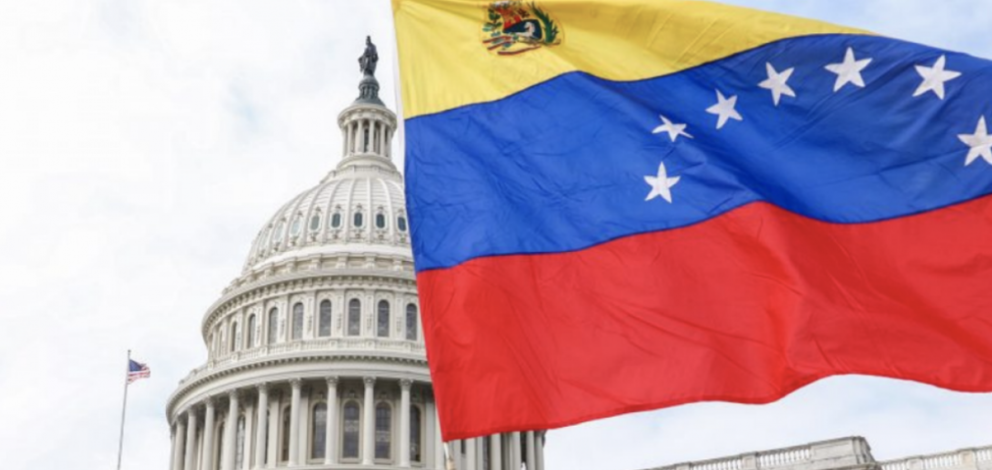
The Venezuelan flag near the US Capitol [Rep. Darren Soto].
ANALYSIS / Alexandria Angela Casarano
On March 8, the Biden administration approved Temporary Protected Status (TPS) for the cohort of 94,000 to 300,000+ Venezuelans already residing in the United States. Nicaragua, Honduras, El Salvador, and Haiti await the completion of litigation against the TPS terminations of the Trump administration. Meanwhile, the US-Mexico border faces surges in migration and detention facilities for unaccompanied minors battle overcrowding.
TPS and DED. The case of El Salvador
TPS was established by the Immigration Act of 1990 and was first granted to El Salvador that same year due to a then-ongoing civil war. TPS is a temporary immigration benefit that allows migrants to access education and obtain work authorization (EADs). TPS is granted to specific countries in response to humanitarian, environmental, or other crises for 6, 12, or 18-month periods-with the possibility of repeated extension-at the discretion of the Secretary of Homeland Security, taking into account the recommendations of the State Department.
The TPS designation of 1990 for El Salvador expired on June 30,1992. However, following the designation of Deferred Enforced Departure (DED) to El Salvador on June 26, 1992 by George W. Bush, Salvadorans were allowed to remain in the US until December 31, 1994. DED differs from TPS in that it is designated by the US President without the obligation of consultation with the State Department. Additionally, DED is a temporary protection from deportation, not a temporary immigration benefit, which means it does not afford recipients a legal immigration status, although DED also allows for work authorization and access to education.
When DED expired for El Salvador on December 31, 1994, Salvadorans previously protected by the program were granted a 16-month grace period which allowed them to continue working and residing in the US while they applied for other forms of legal immigration status, such as asylum, if they had not already done so.
The federal court system became significantly involved in the status of Salvadoran immigrants in the US beginning in 1985 with the American Baptist Churches v. Thornburgh (ABC) case. The ABC class action lawsuit was filed against the US Government by more than 240,000 immigrants from El Salvador, Guatemala, and former Soviet Bloc countries, on the basis of alleged discriminatory treatment of their asylum claims. The ABC Settlement Agreement of January 31, 1991 created a 240,000-member immigrant group (ABC class members) with special legal status, including protection from deportation. Salvadorans protected under TPS and DED until December 31, 1994 were allowed to apply for ABC benefits up until February 16, 1996.
Venezuela and the 2020 Elections
The 1990's Salvadoran immigration saga bears considerable resemblance to the current migratory tribulations of many Latin American immigrants residing in the US today, as the expiration of TPS for four Latin American countries in 2019 and 2020 has resulted in the filing of three major lawsuits currently working their way through the US federal court system.
Approximately 5 million Venezuelans have left their home country since 2015 following the consolidation of Nicolás Maduro, on economic grounds and in pursuit of political asylum. Heavy sanctions placed on Venezuela by the Trump administration have exacerbated-and continue to exacerbate, as the sanctions have to date been left in place by the Biden administration-the severe economic crisis in Venezuela.
An estimated 238,000 Venezuelans are currently residing in Florida, 67,000 of whom were naturalized US citizens and 55,000 of whom were eligible to vote as of 2018. 70% of Venezuelan voters in Florida chose Trump over Biden in the 2020 presidential elections, and in spite of the Democrats' efforts (including the promise of TPS for Venezuelans) to regain the Latino vote of the crucial swing state, Trump won Florida's 29 electoral votes in the 2020 elections. The weight of the Venezuelan vote in Florida has thus made the humanitarian importance of TPS for Venezuela a political issue as well. The defeat in Florida has probably made President Biden more cautious about relieving the pressure on Venezuela's and Cuba's regimes.
The Venezuelan TPS Act was originally proposed to the US Congress on January 15, 2019, but the act failed. However, just before leaving office, Trump personally granted DED to Venezuela on January 19, 2021. Now, with the TPS designation to Venezuela by the Biden administration on March 8, Venezuelans now enjoy a temporary legal immigration status.
The other TPS. Termination and ongoing litigation
Other Latin American countries have not fared so well. At the beginning of 2019, TPS was designated to a total of four Latin American countries: Nicaragua, Honduras, El Salvador, and Haiti. Nicaragua and Honduras were first designated TPS on January 5, 1999 in response to Hurricane Mitch. El Salvador was redesignated TPS on March 9, 2001 after two earthquakes hit the country. Haiti was first designated TPS on January 21, 2010 after the Haiti earthquake. Since these designations, TPS was continuously renewed for all four countries. However, under the Trump administration, TPS was allowed to expire without renewal for each country, beginning with Nicaragua on January 5, 2019. Haiti followed on July 22, 2019, then El Salvador on September 9, 2019, and lastly Honduras on January 4, 2020.
As of March 2021, Salvadorans account for the largest share of current TPS holders by far, at a total of 247,697, although the newly eligible Venezuelans could potentially overshadow even this high figure. Honduras and Haiti have 79,415 and 55,338 TPS holders respectively, and Nicaragua has much fewer with only 4,421.
The elimination of TPS for Nicaragua, Honduras, El Salvador, and Haiti would result in the deportation of many immigrants who for a significant continuous period of time have contributed to the workforce, formed families, and rebuilt their lives in the United States. Birthright citizenship further complicates this reality: an estimated 270,000 US citizen children live in a home with one or more parents with TPS, and the elimination of TPS for these parents could result in the separation of families. Additionally, the conditions of Nicaragua, Honduras, El Salvador, and Haiti-in the context of the COVID-19 pandemic, recent natural disasters (i.e. hurricanes Matthew, Eta, and Iota), and other socioeconomic and political issues-remain far from ideal and certainly unstable.
Three major lawsuits were filed against the US Government in response to the TPS terminations of 2019 and 2020: Saget v. Trump (March 2018), Ramos v. Nielsen (March 2018), and Bhattarai et al. v. Nielsen (February 2019). Kirstjen Nielsen served as Secretary of Homeland Security for two years (2017 - 2019) under Trump. Saget v. Trump concerns Haitian TPS holders. Ramos v. Nielsen concerns 250,000 Salvadoran, Nicaraguan, Haitain and Sudanese TPS holders, and has since been consolidated with Bhattarai et al. v. Nielsen which concerns Nepali and Honduran TPS holders.
All three (now two) lawsuits appeal the TPS eliminations for the countries involved on similar grounds, principally the racial animus (i.e. Trump's statement: "[Haitians] all have AIDS") and unlawful actions (i.e. violations of the Administrative Procedure Act (APA)) of the Trump administration. For Saget v. Trump, the US District Court (E.D. New York) blocked the termination of TPS (affecting Haiti only) on April 11, 2019 through the issuing of preliminary injunctions. For Ramos v. Nielson (consolidated with Bhattarai et al. v. Nielson), the US Court of Appeals of the 9th Circuit has rejected these claims and ruled in favour of the termination of TPS (affecting El Salvador, Nicaragua, Haiti, Honduras, Nepal, and Sudan) on September 14, 2020. This ruling has since been appealed and is currently awaiting revision.
The US Citizenship and Immigration Services (USCIS) and the Department of Homeland Security (DHS) have honored the orders of the US Courts not to terminate TPS until the litigation for these aforementioned cases is completed. The DHS issued a Federal Register Notice (FRN) on December 9, 2020 which extends TPS for holders from Nicaragua, Honduras, El Salvador, and Haiti until October 14, 2021. The USCIS has similarly cooperated and has ordered that so long as the litigation remains effective, no one will lose TPS. The USCIS has also ordered that in case of TPS elimination once the litigation is completed, Nicaragua and Haiti will have 120 grace days to orderly transition out of TPS, Honduras will have 180, and El Salvador will have 365 (time frames which are proportional to the number of TPS holders from each country, though less so for Haiti).
The Biden Administration's Migration Policy
On the campaign trail, Biden repeatedly emphasized his intentions to reverse the controversial immigration policies of the Trump administration, promising immediate cessation of the construction of the border wall, immediate designation of TPS to Venezuela, and the immediate sending of a bill to create a "clear [legal] roadmap to citizenship" for 11 million+ individuals currently residing in the US without legal immigration status. Biden assumed office on January 20, 2021, and issued an executive order that same day to end the government funding for the construction of the border wall. On February 18, 2021, Biden introduced the US Citizenship Act of 2021 to Congress to provide a legal path to citizenship for immigrants residing in the US illegally, and issued new executive guidelines to limit arrests and deportations by ICE strictly to non-citizen immigrants who have recently crossed the border illegally. Non-citizen immigrants already residing in the US for some time are now only to be arrested/deported by ICE if they pose a threat to public safety (defined by conviction of an aggravated felony (i.e. murder or rape) or of active criminal street gang participation).
Following the TPS designation to Venezuela on March 8, 2021, there has been additional talk of a TPS designation for Guatemala on the grounds of the recent hurricanes which have hit the country.
On March 18, 2021, the Dream and Promise Act passed in the House. With the new 2021 Democrat majority in the Senate, it seems likely that this legislation which has been in the making since 2001 will become a reality before the end of the year. The Dream and Promise Act will make permanent legal immigration status accessible (with certain requirements and restrictions) to individuals who arrived in the US before reaching the age of majority, which is expected to apply to millions of current holders of DACA and TPS.
If the US Citizenship Act of 2021 is passed by Congress as well, together these two acts would make the Biden administration's lofty promises to create a path to citizenship for immigrants residing illegally in the US a reality. Since March 18, 2021, the National TPS Alliance has been hosting an ongoing hunger strike in Washington, DC in order to press for the speedy passage of the acts.
The current migratory surge at the US-Mexico border
While the long-term immigration forecast appears increasingly more positive as Biden's presidency progresses, the immediate immigration situation at the US-Mexico border is quite dire. Between December 2020 and February 2021, the US Customs and Border Protection (CBP) reported a 337% increase in the arrival of families, and an 89% increase in the arrival of unaccompanied minors. CBP apprehensions of migrants crossing the border illegally in March 2021 have reached 171,00, which is the highest monthly total since 2006.
Currently, there are an estimated 4,000 unaccompanied minors in CBP custody, and an additional 15,000 unaccompanied minors in the custody of the Department of Health and Human Services (HHS).
The migratory CBP facility in Donna, TX designated specifically to unaccompanied minors has been filled at 440% to 900% of its COVID-19 capacity of just 500 minors since March 9, 2021. Intended to house children for no more than a 72-hour legal limit, due to the current overwhelmed system, some children have remained in the facility for more than weeks at a time before being transferred on to HHS.
In order to address the overcrowding, the Biden administration announced the opening of the Delphia Emergency Intake Site (next to the Donna facility) on April 6, 2021, which will be used to house up to 1,500 unaccompanied minors. Other new sites have been opened by HHS in Texas and California, and HHS has requested the Pentagon to allow it to temporarily utilize three military facilities in these same two states.
Political polarization has contributed to a great disparity in the interpretation of the recent surge in migration to the US border since Biden took office. Termed a "challenge" by Democrats and a "crisis" by Republicans, both parties offer very different explanations for the cause of the situation, each placing the blame on the other.
Following referendums in 2018 and 2019, the Guatemalan government submitted its report to The Hague in 2020 and the Belizean government has one year to reply.
Guatemala presented its position before the International Court of Justice in The Hague last December, with a half-year delay attributed to the Covid-19 emergency status ; Belize will now have a year to respond. Although the ICJ will then take its time to draft a judgement, it can be said that the territorial dispute between the two neighbours has entered its final stretch, bearing in mind that the dispute over this Central American enclave dates back to the 18th century.
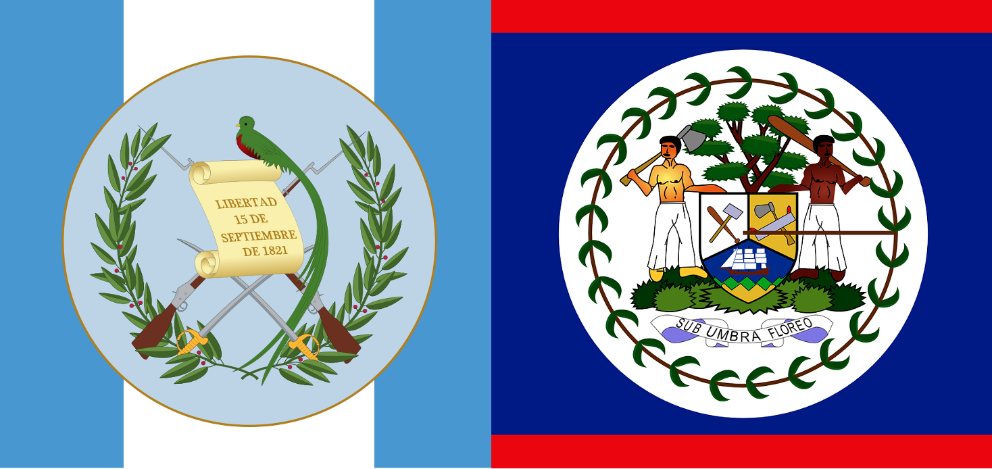
Coats of arms of Guatemala (left) and Belize (right) on their respective flags.
article / Álvaro de Lecea
The territorial conflict between Guatemala and Belize has its roots in the struggle between the Spanish Empire in the Americas and British activity in the Caribbean during the colonial era. The Spanish Crown's inaction in the late 18th century in the face of British encroachment on what is now Belize, then Spanish territory, allowed the British to establish a foothold in Central America and begin exploiting mainland lands for precious woods such as dyewood and mahogany. However, Guatemala's reservations over part of the Belizean land - it claims over 11,000 square kilometres, almost half of the neighbouring country; it also claims the corresponding maritime extension and some cays - generated a status of tension and conflict that has continued to the present day.
In 2008, both countries decided to hold referendums on the possibility of taking the dispute to the International Court of Justice (ICJ), which would rule on the division of sovereignty. The Belizeans approved taking that step in 2018 and the Guatemalans the following year. The issue was formalised before the ICJ in The Hague on 12 June 2019.
Historical context
The territory of present-day Belize was colonised by Spain in the mid-16th century as part of the Viceroyalty of New Spain and dependent on the captaincy of Guatemala. However, as there were no mineral resources there and hardly any population, the metropolis paid little attention to the area. This scant Spanish presence favoured pirate attacks, and to prevent them, the Spanish Crown allowed increasing English exploitation in exchange for defence. England carried out a similar penetration on the Caribbean coast of Nicaragua, but while the Spanish managed to expel the English from there, they consolidated their settlement at area Belize and finally obtained the territory by the Treaty of Paris in 1783, whereby Spain disengaged itself from this corner of Central America. That concession and another three years later covered just 6,685 square kilometres, a space close to the coast that was later enlarged inland and southward by England, since Spain was not active in the area. From then on the enclave became known as "British Honduras".
The cession did not take into account the claims of the Guatemalans, who considered the space between the Sarstún and Sibún rivers to be their own. Both rivers run west-east, the former forming the border with Guatemala in the south of what is now Belize; the other, further north, runs through the centre of Belize, flowing into the capital, splitting the country in two. However, given the urgency for international recognition when it declared independence in 1821, Guatemala signed several agreements with England, the great power of the day, to ensure the viability of the new state. One of these was the Aycinena-Wyke Treaty (1859), whereby Guatemala accepted Belize's borders in exchange for the construction of a road to improve access from its capital to the Caribbean. However, both sides blamed the other for not complying with the treaty (the road was not built, for example) and Guatemala declared it null and void in 1939.
In the constitution enacted in 1946, Guatemala included the claim in the drafting, and has insisted on this position since the neighbouring country, under the name Belize, gained its independence from the United Kingdom in 1981. As early as 1978, the UN passed a resolution guaranteeing the rights to self-determination and territorial protection of the Belizean people, which also called for a peaceful resolution of the neighbouring conflict. Guatemala did not recognise the existence of the new sovereign state until 1991, and even today still places some limits on Belize's progressive integration into the Central American Integration System. Because of its English background, Belize has historically maintained a closer relationship with the English-speaking Caribbean islands.
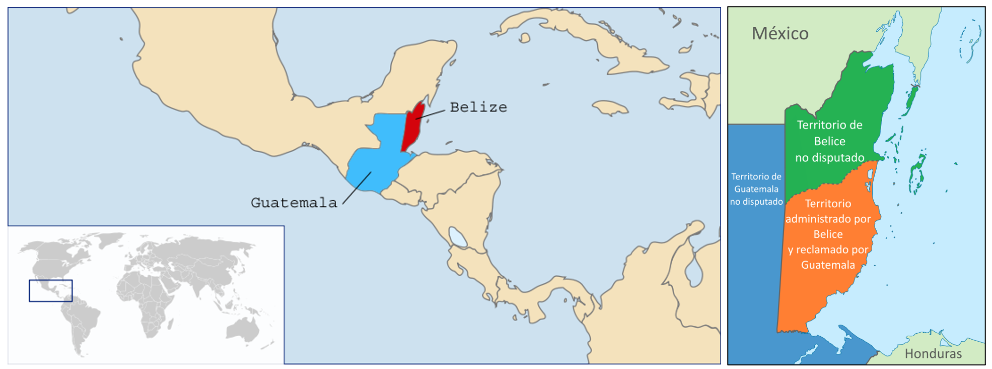
Map of Central America and, in detail, the territorial dispute between Guatemala and Belize [Rei-artur / Janitoalevic Bettyreategui].
Adjacency Line and the role of the OAS
Since 2000, the Organisation of American States (OAS), of which both nations are members, has been mediating between the two countries. In the same year, the OAS facilitated a agreement with the goal aim of building confidence and negotiations between the two neighbours. In order to achieve these objectives, the OAS, through its Peace Fund, actively supported the search for a solution by providing technical and political support. Indeed, as a result of this rapprochement, talks on the dispute were resumed and the creation of the "Adjacency Line" was agreed.
This is an imaginary line that basically follows the line that "de facto" separated the two countries from north to south and is where most of the tensions are taking place. Over the years, both sides have increased their military presence there, in response to incidents attributed to the other side. Due to these frequent disputes, in 2015 Belize had to request financial aid military presence from the British navy. It is precisely in the Adjacency Zone that an OAS office is located, whose purpose purpose is to promote contacts between the communities and to verify certain transgressions of the agreements already signed.
One of the most promising developments that took place under the umbrella of the OAS was the signature in 2008 of what was called the "specialagreement between Guatemala and Belize to submit Guatemala's territorial, insular and maritime claim to the International Court of Justice". Under this agreement both countries undertook to submit the acceptance of the Court's mediation to simultaneous popular consultations. However, in 2015, through the protocol of the agreement Special between Belize and Guatemala, these popular consultations were not allowed to take place at the same time. Both parties committed to accept the Court's decision as "decisive and binding" and to comply with and implement it "fully and in good faith".
The Hague and the impact of the future resolution
The referendums were held in 2018 in the case of Guatemala and in 2019 in the case of Belize. Although the percentages of both popular consultations were somewhat mixed, the results were positive. In Belize, the Yes vote won 55.37% of the votes and the No vote 44.63%. In Guatemala, on the other hand, the results were much more favourable for the Yes vote, with 95.88% of the votes, compared to 4.12% for the No vote.
These results show how the Belizeans are wary of resorting to the Hague's decision because, although by fixing final the border they will forever close any claim, they risk losing part of their territory. On the other hand, the prospect of gain is greater in the Guatemalan case, since if its proposal is accepted - or at least part of it - it would strategically expand its access to the Caribbean, now somewhat limited, and in the event of losing, it would simply remain as it has been until now, which is not a serious problem for the country.
The definition of a clear and respected border is necessary at this stage. The adjacent line, observed by the OAS peace and security mission statement , has been successful in limiting tensions between the two countries, but the reality is that certain incidents continue to take place in this unprotected area. These incidents, such as the assassination of citizens of both countries or mistreatment attributed to the Guatemalan military, cause the conflict to drag on and tensions to rise. On the other hand, the lack of a clear definition of borders facilitates drug trafficking and smuggling.
This conflict has also affected Belize's economic and trade relations with its regional neighbours, especially Mexico and Honduras. This is not only due to the lack of land boundaries, but also to the lack of maritime boundaries. This area is very rich in natural resources and has the second largest coral reef reservation in the world, after Australia. This has, unsurprisingly, affected bilateral relations between the two countries. Whilst regional organisations are calling for greater regional integration, the tensions between Belize and Guatemala are preventing any improvement in this regard.
The Guatemalan president has stated that, regardless of the Court's result , he intends to strengthen bilateral relations, especially in areas such as trade and tourism, with neighbouring Belize. For their part, the Caricom heads of state expressed their support for Belize in October 2020, their enthusiasm for the ICJ's intervention and their congratulations to the OAS for its mediation work.
The country left the cartel in order to expand pumping, but the Covid-19 crisis has cut extraction volumes by 10.8%.
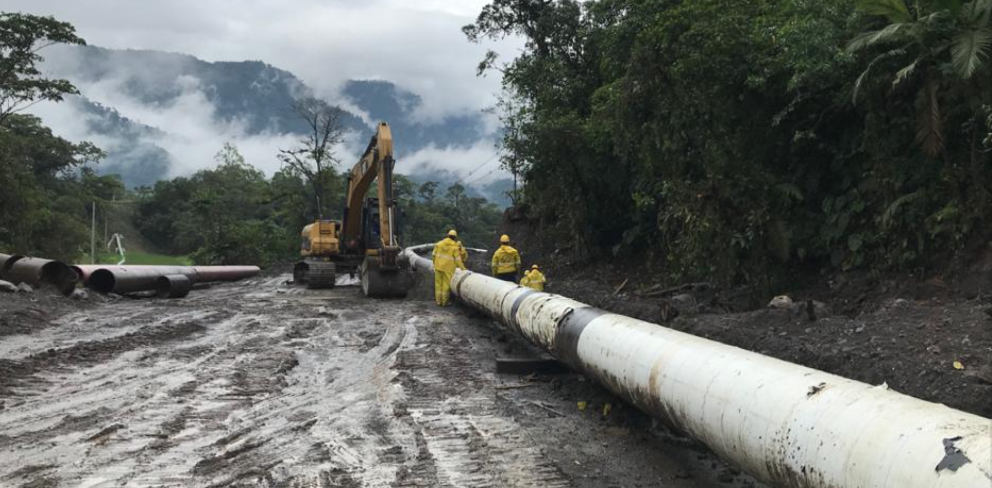
Construction of a variant of the oil pipeline that crosses the Andes, from the Ecuadorian Amazon to the Pacific [Petroecuador].
ANALYSIS / Jack Acrich and Alejandro Haro
Ecuador left the Organisation of Petroleum Exporting Countries (OPEC) on 1 January 2020 to avoid having to continue to join the production cuts imposed by group , which it agrees to in order to push up the world price of crude oil. Ecuador preferred to sell more barrels, albeit at a lower price, because by exporting more at the end of the day written request it could increase its income and thus get out of its serious financial situation status , which the coronavirus emergency has only accentuated, with a fall in GDP in 2020 currently estimated at 9.5 per cent.
However, domestic economic difficulties and the difficult international situation have not only prevented Ecuador from expanding pumping, but oil production has fallen by 10.8% in the last year. average In 2020, Ecuador extracted 472,000 barrels of oil per day, especially affected by the sharp reduction in activity in April with the beginning of the confinement, which was not compensated for the rest of the year. agreement This is a volume that is below the 500,000 line that has always been exceeded in recent years (in 2019 production was 528,000), according to figures from Petroecuador, the state hydrocarbons company. The reduction in global consumption during the Covid-19 year also correlated with a drop in the consumption of derivatives in Ecuador, especially gasoline and diesel, which fell by 18.5%.
International investment constrained by the pandemic context and reduced consumption marked a status that could hardly lead to an increase in production. In 2020, Ecuador saw a drop in the value of oil exports of 42.1% (twice as much as total exports), which, combined with a deterioration in the price of a barrel of oil, meant a 40.9% reduction in public revenue from the oil sector, according to the International Monetary Fund (IMF) data .
The figures for the first two months of 2021 indicate an accentuation of the fall in crude oil production (-4.73% compared to January and February 2020) and derivatives (-7.47%), as well as their export (-22.8%).
Cutting expense and seeking oil revenues
Exiting OPEC did not pose any particular risk for Ecuador, which had already left the organisation in a previous period. Its limited weight in OPEC and the progressive decline in the cartel's own strength meant that Ecuador's attempt to go it alone was not particularly costly. The absolute priority of Lenín Moreno's government was to rebalance the country's macroeconomic picture - battered by the high public expense of his predecessor, Rafael Correa - and for this it urgently needed to increase state revenue, a significant part of which in Ecuador normally comes from the hydrocarbons sector.
When he became president in 2017, Moreno set out to steer the country towards more market-friendly energy policies. The president was determined to break with the nationalist approach of his predecessor, whose policies discouraged foreign investment in the oil industry while significantly increasing public debt. Among the most costly programmes undertaken by Correa was to maintain high subsidies for energy consumption, with especially low fuel prices.
In order to overcome the financial status that Ecuador found itself in when he took office, Moreno approached the IMF to apply for financial aid financial, and committed to structural reforms, including the gradual dismantling of subsidies. These reforms, however, were not well received and the social unrest that spread throughout the country put further pressure on the oil industry.
In February 2019, Moreno negotiated an IMF loan to help reduce the country's large fiscal deficit and huge external debt, which by the end of 2018 had reached 46.1 per cent of GDP and twelve months later would reach 51.8 per cent. The committed 'bailout' was for $10.2 billion, of which $6.5 billion came from the IMF and the rest from other international agencies.
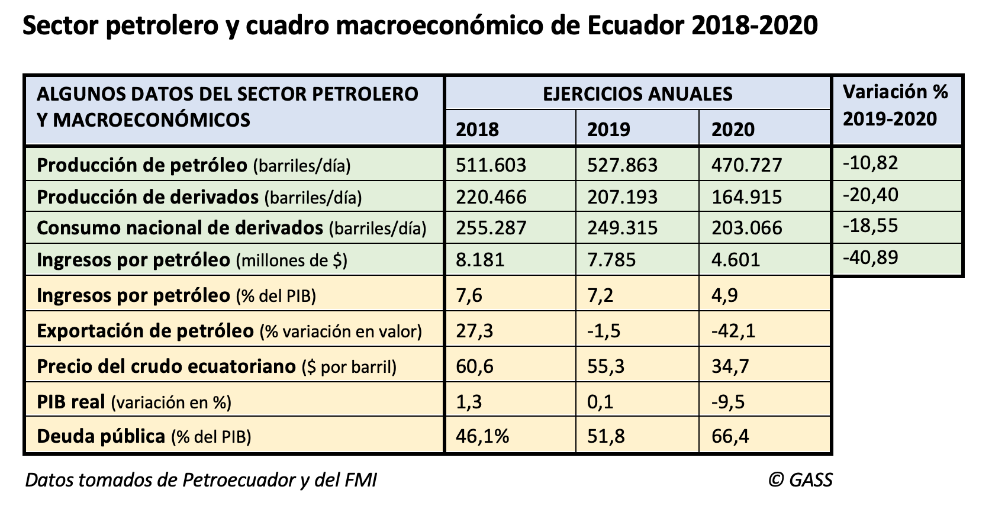
As part of austerity measures agreed with the IMF, Moreno was forced to end government subsidies that had kept petrol prices low for decades. In early October 2019 he announced a plan of cuts to save $2.27 billion a year, essentially withdrawing the fuel subsidy. The advertisement decree, which would later be annulled, immediately provoked massive protests, both from transporters and low-income sectors, as well as most notably from indigenous communities. The street violence forced the president to leave Quito for a few days and move to Guayaquil.
To address the need for revenue, Moreno sought to rely on the oil industry, which accounts for roughly a third of the country's total exports. He initially expressed the intention to seek a rise from the 545,000 barrels of crude oil produced at the time to almost 700,000 barrels a day.
goal One of the measures taken in this direction was to promote the development and the exploitation of the Ishpingo-Tiputini-Tambococha field, with the aim of increasing oil production by 90,000 barrels a day. This decision met with social rejection due to the environmental damage it could cause, as the Yasuní National Park, in the Ecuadorian Amazon, has been declared a protected area. The government then decided to postpone the expansion of production, first to 2021 and then to 2022. The civil service examination was especially led by indigenous communities, in a mobilisation that partly explains the success in the 2021 presidential elections of Yaku Pérez's indigenist Pachakutik movement, which almost made it to the second round.
Another measure was to reverse some of his predecessor's emblematic policies. For example, he eliminated the service contracts introduced under President Correa, thus restoring the model production-sharing contract. This reform was more favourable to international oil companies, as it allowed them to retain a share of oil reserves; it also offered them financial incentives to invest in the country. The new model was first applied in the tenders awarded during the twelfth Intracampos oil round, in the Oriente region, which is rich in oil reserves. Under this contract modality , the Moreno administration awarded seven of the eight exploration blocks on offer with a total investment of more than $1.17 billion.
Fall in production
Due to the urgency of increasing revenues, Ecuador resisted the plan of production cuts that OPEC has been imposing on its members at various times since the abrupt fall in oil prices in 2014. Initially, the organisation accepted that some of its members, with moderate or very low production volumes compared to previous figures, as was the case of Venezuela, would maintain their extraction rates. But since it could no longer be an exception, Ecuador preferred to announce at the end of 2019 that it would leave OPEC and not have to reduce its production to 508,000 barrels per day in 2020, which was the quota set for it.
What is striking is that last year production finally fell from 528,000 barrels per day in 2019 to 472,000 (a drop of 10.8%), and not because of decisions taken at OPEC headquarters in Vienna but because of the various difficulties subject caused by the Covid-19 crisis. Petroecuador's oil exports fell from 331,321 barrels per day in 2019 to 316,000, a drop of 4.6%, which in monetary terms was greater, as the price of a barrel of Ecuadorian mixed oil fell from 55.3 dollars in 2019 to 34.7 in 2020.
One element that makes it difficult for Ecuador to take better advantage of its hydrocarbon potential is that it has insufficient infrastructure for refining crude oil. The country has three refineries, but their capacity does not reach the volume of domestic consumption of oil derivatives, which means that it must import diesel, naphtha and other products. This means that in times of high oil prices, Ecuador benefits from exports, but also has to pay a higher invoice price for imports of derivatives. In 2020, Petroecuador had to import 137,300 barrels per day.
The complicated situation caused by the pandemic has continued to put pressure on Ecuador's public debt, which reached 66.4% at the end of 2020, despite all the attempts made by the Moreno government to reduce it.
The next president, due to take office at the end of May 2021, will also have little room for manoeuvre due to these debt volumes and will have to continue to rely on higher oil revenues to balance public finances. The expansionary policies of expense during Correa's presidency took place in the context of the commodity super-cycle, which benefited South America so much, but this is unlikely to be repeated in the short term deadline.
OPEC's loss of weight
With its departure from OPEC, Ecuador left an international organisation that was created in 1960 with the aim of regulating the world oil market and controlling oil prices to a certain extent. goal . The founding members were Iran, Iraq, Kuwait, Saudi Arabia and Venezuela. Over time, other countries joined OPEC and today it is made up of thirteen members: Algeria, Angola, Republic of Congo, Equatorial Guinea, Gabon, Libya, Nigeria, United Arab Emirates and the five founding countries. When it was created, the organisation sought to establish, acting as a cartel, a kind of counterweight to a series of Western energy transnationals, mainly from the United States and the United Kingdom. OPEC members account for about 40 per cent of world oil production and contain about 80 per cent of the world's proven oil reserves. To be admitted as a member of the organisation it is necessary to have substantial oil exports and to share those of the member countries.
Ecuador joined OPEC in 1973, but suspended its membership in 1992. Subsequently, in 2007 it resumed active participation until its leave in January 2020. Considering that Ecuador was one of OPEC's smaller members, it did not really have much influence in the organisation and its exit does not represent a substantial loss for the organisation. However, it is a second departure in just one year, as Qatar, which had more weight in the cartel, left on 1 January 2019. In its case, its divorce from OPEC was due to other reasons, such as its tensions with Saudi Arabia and its desire to focus on the gas sector, of which it is one of the world's largest producers.
These moves are an example of OPEC's loss of influence. This has led it to establish alliances with producers that are not part of the organisation, such as Russia and some other countries forming OPEC+. With the decline of oil production in Venezuela and the decreasing ability of other members to control their production and exports, Saudi Arabia has been increasingly consolidating its position as the cartel's leader, accounting for around a third of the total production, with approximately 9.4 million barrels per day. In a way, Saudi Arabia and Russia remain, in a head to head battle, as the main countries seeking to cut production in an attempt to increase prices. Additionally, thanks to fracking, the United States has become the largest oil producer, representing a major influence on the international crude oil market, affecting the power that OPEC may have.
The hydrocarbon field is the centrepiece of President Alberto Fernández's 2020-2023 Gas Plan, which subsidises part of the investment.
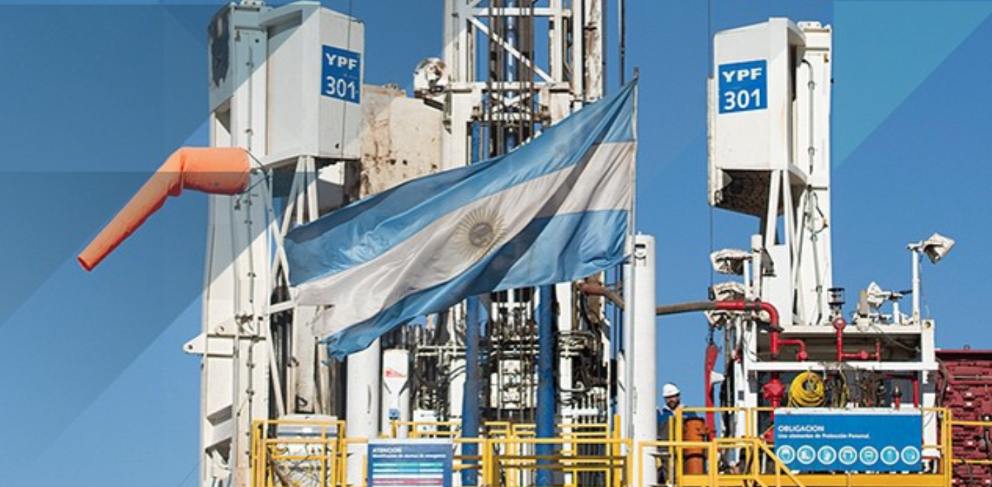
Activity of YPF, Argentina's state-owned hydrocarbon company [YPF].
ANALYSIS / Ignacio Urbasos Arbeloa
Argentina is facing a deep economic crisis that is having a severe impact on the standard of living of its citizens. The country, which had managed to emerge with enormous sacrifices from the corralito of 2001, sees its leaders committing the same macroeconomic recklessness that led the national Economics to collapse. After a hugely disappointing mandate by Mauricio Macri and his economic "gradualism", the new administration of Alberto Fernández has inherited a very delicate status , now aggravated by the global and national crisis generated by Covid-19. Public debt is now almost 100% of GDP, the Argentine peso is worth less than 90 units to the US dollar, while the public deficit persists. The Economics is still in recession, accumulating four years of decline. The IMF, which lent nearly $44 billion to Argentina in 2018 in the largest loan in the institution's history, has begun to lose patience with the lack of structural reforms and hints of debt restructuring by the government. In this critical status , Argentines are looking to the development unconventional oil industry as a possible way out of the economic crisis. In particular, the Vaca Muerta super field has been the focus of attention of international investors, government and citizens for the last decade, being a very promising project not Exempt of environmental and technical challenges.
The energy sector in Argentina: a history of fluctuations
The oil sector in Argentina has more than 100 years of history since oil was discovered in the Patagonian desert in 1907. The geographical difficulties of area - lack of water, distance from Buenos Aires and salty winds of more than 100 km/h - meant that project advanced very slowly until the outbreak of the First World War. The European conflict interrupted coal imports from England, which until then had accounted for 95% of Argentina's energy consumption. business The emergence of oil in the inter-war period as a strategic raw subject commodity revalued the sector, which began to receive huge foreign and domestic investment in the 1920s. By 1921, YPF, the first state-owned oil company in Latin America, was created, with energy self-sufficiency as its main goal goal. The country's political upheaval during the so-called Década Infame (1930-43) and the effects of the Great Depression damaged the incipient oil sector. The years of Perón's government saw a timid take-off of the oil industry with the opening of the sector to foreign companies and the construction of the first oil pipelines. In 1958, Arturo Frondizi became President of Argentina and sanctioned the Hydrocarbons Law of 1958, achieving an impressive development of the sector in only 4 years with an immense policy of public and private investment that multiplied oil production threefold, extended the network of gas pipelines and generalised access to natural gas for industry and households. The oil regime in Argentina kept the ownership of resource in the hands of the state, but allowed the participation of private and foreign companies in the production process.
Since the successful 1960s in subject oil, the sector entered a period of relative stagnation in parallel with Argentina's chaotic politics and Economics at the time. The 1970s was a complex journey in the desert for YPF, mired in huge debt and unable to increase production and secure the longed-for self-sufficiency.
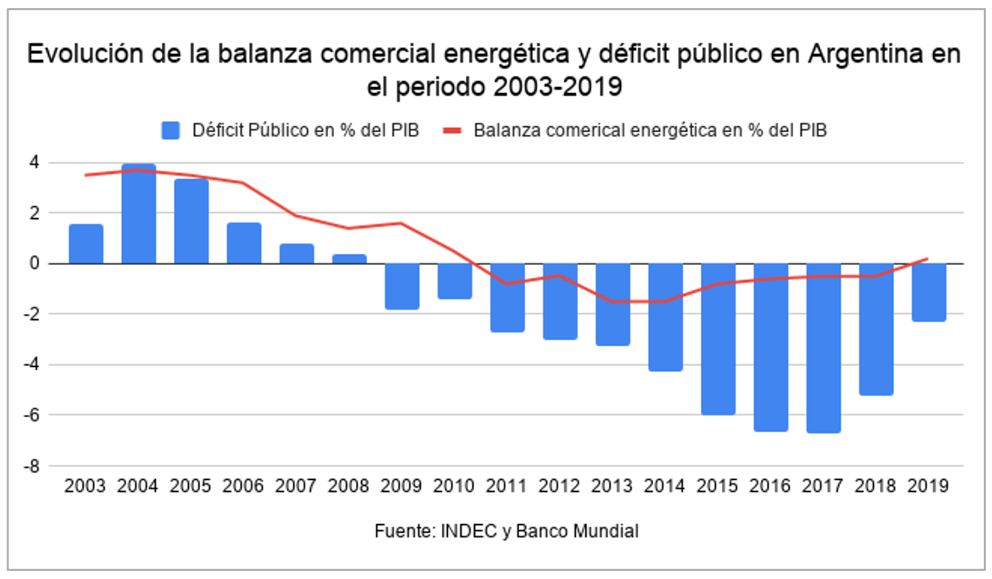
The so-called Washington Consensus and the arrival of Carlos Menem to the presidency in 1990 saw the privatisation of YPF and the fragmentation of the state monopoly over the sector. By 1998, YPF was fully privatised under the ownership of Repsol, which controlled 97.5% of its capital. It was in the period 1996-2003 that peak oil production was reached, exporting natural gas to Chile, Brazil and Uruguay, and exceeding 300,000 barrels of crude oil per day in net exports.
However, a turnaround soon began in the face of state intervention in the market. Domestic consumption with fixed sales prices for oil producers was less attractive than the export market, encouraging private companies to overproduce in order to export oil and increase revenues exponentially. With the rise in oil prices of the so-called "commodity super-cycle" during the first decade of this century, the price differential between exports and domestic sales widened, creating a real incentive to focus on production. Exploration was thus left in the background, as domestic consumption grew rapidly due to tax incentives and a near horizon was foreseen without the possibility of exports and, therefore, lower income from the increase in reserves.
The exit from the 2001 crisis took place in a context of fiscal and trade surpluses, which allowed the country to regain the confidence of international creditors and reduce the volume of public debt. It was precisely the energy sector that was the main driver of this recovery, accounting for more than half of the trade surplus in the period 2004-2006 and one of Argentina's main sources of fiscal revenue. However, as mentioned above, this production was not sustainable due to the existence of a fiscal framework that distorted oil companies' incentives in favour of immediate consumption without investing in exploration. By 2004, a new tariff was applied to crude oil exports that floated on the basis of the international price of crude, reaching 45% if the price was above 45 dollars. The excessively rentier approach of Néstor Kirchner's presidency ended up dilapidating the sector's investment incentives, although it is true that they allowed for a spectacular increase in derived fiscal revenues, boosting Argentina's generous social and debt repayment plans. sample As a good illustration of this decline in exploration, in the 1980s more than 100 exploratory wells were drilled annually, in 1990 the figure exceeded 90, and by 2010 the figure was 26 wells per year. This figure is particularly dramatic if one takes into account the dynamics that the oil and gas sector tends to follow, with large investments in exploration and infrastructure in times of high prices, as was the case between 2001-2014.
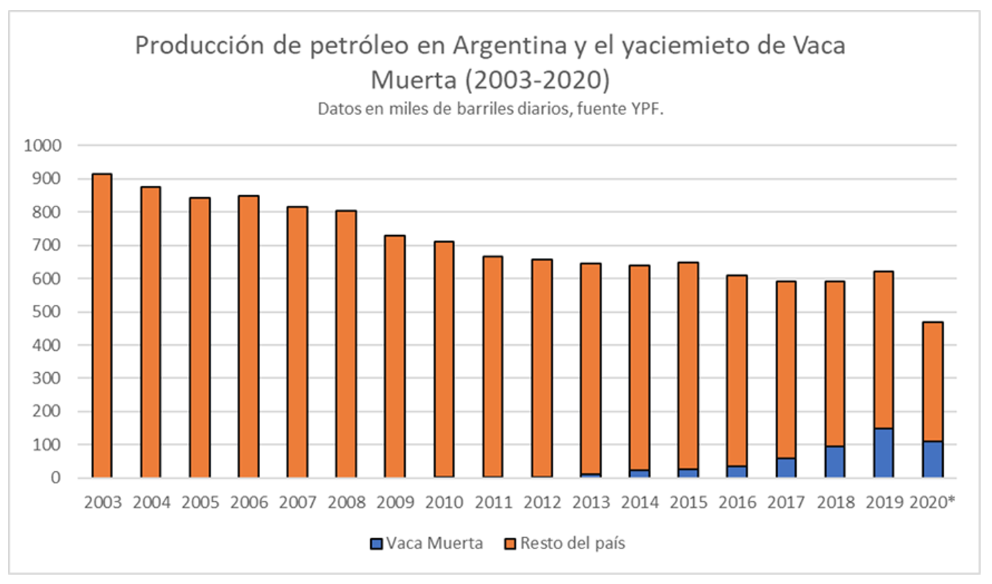
In 2011, after a decade of debate on the oil sector in Argentina, President Cristina Fernández decided to expropriate 51 per cent of the shares of YPF held by Repsol, citing reasons of energy sovereignty and the decline of the sector. This decision followed the line taken by Hugo Chávez and Evo Morales in 2006 to increase the state's weight in the hydrocarbons sector at a time of electoral success for the Latin American left. The expropriation took place in the same year that Argentina became a net energy importer and coincided with the finding of the large shale reserves in Neuquén precisely by YPF, now known as Vaca Muerta. YPF at the time was the direct producer of approximately one third of Argentina's total volume. The expropriation took place at the same time as the imposition of the "cepo cambiario", a system of capital controls that made private foreign investment in the sector even less attractive. Not only was the country unable to recover its energy self-sufficiency, but it also entered a period of intense imports that hampered access to dollars and produced a large part of the macroeconomic imbalance of the current economic crisis.
The arrival of Mauricio Macri in 2015 heralded a new phase for the sector with policies more favourable to private initiative. One of the first measures was to establish a fixed price at the "wellhead" of the Vaca Muerta oil fields with the idea of encouraging the start-up of projects. As the economic crisis worsened, the unpopular measure of increasing electricity and fuel prices by more than 30 per cent was chosen, generating enormous discontent in the context of a constant devaluation of the Argentine peso and the rising cost of living. The energy portfolio was marked by enormous instability, with three different ministers who generated enormous legal insecurity by constantly changing the hydrocarbons regulatory framework . Renewable solar and wind energy, boosted by a new energy plan and greater liberalisation of investment, managed to double their energy contribution during Mauricio Macri's time in the Casa Rosada.
Alberto Fernández's first years have been marked by unconditional support for the hydrocarbons sector, with Vaca Muerta being the central axis of his energy policy, announcing the 2020-2023 Gas Plan that will subsidise part of the investment in the sector. On the other hand, despite the context of the health emergency, 39 renewable energy projects were installed in 2020, with an installed capacity of around 1.5 GW, an increase of almost 60% over the previous year. In any case, the continuity of this growth will depend on access to foreign currency in the country, which is essential to be able to buy panels and windmills from abroad. The boom in renewable energy in Argentina led the Danish company Vestas to install the first windmill assembly plant in the country in 2018, which already has several plants producing solar panels to supply domestic demand.
Characteristics of Vaca Muerta
Vaca Muerta is not a field from a technical point of view, it is a sedimentary training of enormous magnitude with dispersed deposits of natural gas and oil that can only be exploited with unconventional techniques: hydraulic fracturing and horizontal drilling. These characteristics make Vaca Muerta a complex activity, which requires attracting as much talent as possible, especially from international players with experience in the exploitation of unconventional hydrocarbons. Likewise, conditions in the province of Neuquén are complex given the scarcity of rainfall and the importance of the fruit and vegetable industry, in direct competition with the water resources required for the exploitation of unconventional oil.
Since finding, the potential of Vaca Muerta has been compared to that of the Eagle Ford basin in the United States, which produces more than one million barrels per day. Evidently, the Neuquén region has neither Texas' oil business ecosystem nor its fiscal facilities, making what might be geologically similar in reality two totally different stories. In December 2020, Vaca Muerte produced 124,000 barrels of oil per day, a figure that is expected to gradually increase over the course of this year to 150,000 barrels per day, about 30% of the 470,000 barrels per day Argentina produced in 2020. Natural gas follows a slower process, pending the development of infrastructure that will allow the transport of large volumes of gas to consumption and export centres. In this regard, Fernández announced in November 2020 the Plan for the Promotion of Argentine Gas Production 2020-2023, with which the Casa Rosada seeks to save dollars by substituting imports. The plan facilitates the acquisition of dollars for investors and improves the maximum selling price of natural gas by almost 50%, to 3.70 dollars per mbtu, in the hope of receiving the necessary investment, estimated at 6.5 billion dollars, to achieve gas self-sufficiency. Argentina already has the capacity to export natural gas to Chile, Uruguay and Brazil through pipelines. Unfortunately, the floating vessel exporting natural gas from Vaca Muerte left Argentina at the end of 2020 after YPF unilaterally broke the ten-year contract with the vessel's owner, Exmar, citing economic difficulties, limiting the capacity to sell natural gas outside the continent.
One of the great advantages of Vaca Muerta is the presence of international companies with experience in the aforementioned US unconventional oil basins. The post-2014 learning curve of the US fracking sector is being applied in Vaca Muerta, which has seen drilling costs fall by 50% since 2014 while gaining in productivity. The influx of US capital may accelerate if Joe Biden's administration fiscally and environmentally restricts oil activities in the country, from agreement with its environmentalist diary . Currently the main operator in Vaca Muerta after YPF is Chevron, followed by Tecpetrol, Wintershell, Shell, Total and Pluspetrol, in an ecosystem with 18 oil companies working in different blocks.
Vaca Muerta as a national strategy
It is clear that achieving energy self-sufficiency will help Argentina's macroeconomic problems, the main headache for its citizens in recent years. No Exempt of environmental risk, Vaca Muerta could be a lifeline for a country whose international credibility is at an all-time low. Alberto Fernández's pro-hydrocarbon narrative follows the line of his Mexican counterpart Andrés guide López Obrador, with whom he intends to lead a new moderate left-wing axis in Latin America. The spectre of the nationalisation of YPF by the now vice-president Cristina Fernández, as well as the recent breach of contract with Exmar, continue to generate uncertainty among international investors. status Moreover, the poor financial performance of YPF, the main player in Vaca Muerta, with a debt of more than 8 billion dollars, is a major drag on the country's oil prospects. Similarly, Vaca Muerta is far from realising its potential, with significant but insufficient production to guarantee revenues that would bring about a radical change in Argentina's economic and social status . In order to guarantee its success, a context of favourable oil prices and the fluid arrival of foreign investors are needed. Two variables that cannot be taken for granted given Argentina's political context and the increasingly strong decarbonisation policy of traditional oil companies.
The big question now is how to reconcile the large-scale fossil fuel development with Argentina's latest commitments on climate change subject : to reduce CO2 emissions by 19% by 2030 and achieve carbon neutrality by 2050. Similarly, the promising trajectory of renewable energy development during Mauricio Macri's presidency may lose momentum if the oil and gas sector attracts public and private investment, crowding out solar and wind.
Vaca Muerta is likely to advance slowly but surely as international oil prices stabilise upwards. The possibility of generating foreign currency and boosting a Economics on the verge of collapse should not be underestimated, but expecting Vaca Muerta to solve Argentina's problems on its own can only end in a new episode of frustration in the southern country.
Several countries in the Americas are celebrating in 2021 their two hundredth anniversary of a break with Spain that did not always mean independence.ca celebrate in 2021 their two centuries of a break with Spain that did not always mean independence. final
This year, several American nations are commemorating two centuries of their separation from Spain, recalling a process that took place in all the Spanish possessions in continental America within a few years of each other. In some cases, it was a process of successive independence, as was the case with Guatemala, which later belonged to the Mexican Empire and then to a Central American republic, and Panama, which was part of Colombia until the 20th century. But even later, both countries experienced direct interference by the United States, in episodes that were very decisive for the region as a whole.
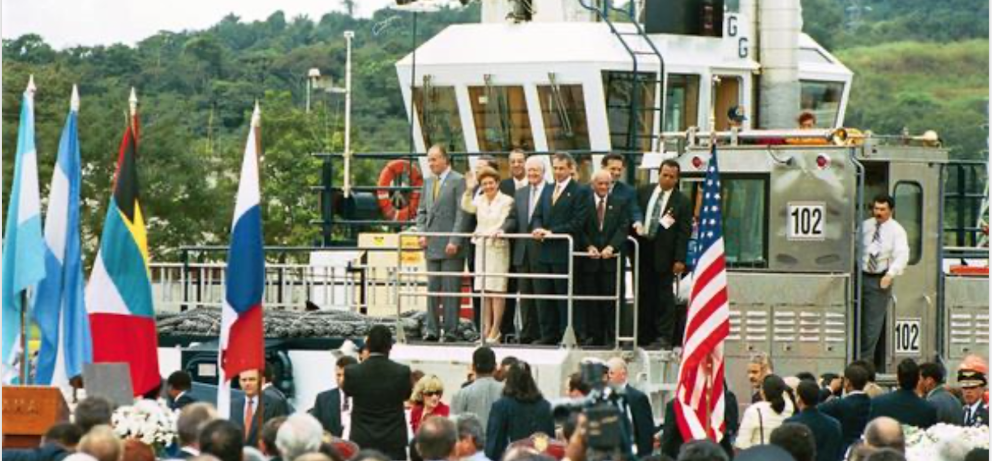
Ceremony of submission of the Panama Canal to the Panamanian authorities, 31 December 1999
article / Angie Grijalva
During 2021 several American countries celebrate their independence from Spain, the largest and most festively celebrated being Mexico. In other nations, the date of 1821 is qualified by later historical developments: Panama also commemorates every year the day in 1903 when it broke with Bogotá, while in the case of Guatemala that independence did not immediately imply a republic of its own, since together with its neighbouring nations in 1822 it was nominally dependent on Mexico and between 1823 and 1839 it formed part of the United Provinces of Central America and the Federal Republic of Central America. Moreover, US regional hegemony called into question the full sovereignty of these countries in subsequent decades: Guatemala suffered the first coup d'état openly promoted by Washington in the Western Hemisphere in 1954, and Panama did not have full control over its entire territory until the Americans handed over the canal in 1999.
Panama and its canal
The project of the Panama Canal was important for the United States because it made it possible to easily link its two coasts by sea and consolidated the global rise sought by Theodore Roosevelt's presidency, guided by the maxim that only the nation that controlled both oceans would be a truly international power. Given the refusal of Colombia, to which the province of Panama then belonged, to accept the conditions set by the United States to build the canal, resuming the work on the paralysed French project , Washington was faced with two options: invade the isthmus or promote Panama's independence from Colombia[1]. The Republic of Panama declared its independence on 3 November 1903 and with it Roosevelt negotiated a very favourable agreement which gave the United States perpetual sovereignty over the canal and a wide strip of land on either side of it. Washington thus gained control of Panama and extended its regional dominance.
After a decade of difficult work and a high issue death toll among the workforce, who came from all over the Caribbean and also from Asia, not least due to dengue fever, malaria and yellow fever, in 1913 the Atlantic and Pacific oceans were finally connected and the canal was opened to ship traffic.
Over time, US sovereignty over a portion of the country and the instructions military installations there fuelled a rejection movement in Panama that became particularly virulent in the 1960s. The Carter Administration agreed to negotiate the cession of the canal in a 1977 agreement that incorporated the Panamanians into the management of inter-oceanic traffic and set the submission of all installations for 1999. When this finally happened, the country experienced the occasion as a new independence celebration, saying goodbye to US troops that only ten years earlier had been very active, invading Panama City and other areas to arrest President Manuel Noriega for drug trafficking.
Critical moment in Guatemala
The Panama Canal gave the United States an undoubted projection of power over its hemisphere. However, during the Cold War, Washington also found it necessary to use operations, in some cases direct, to overthrow governments it considered close to communism. This happened with the overthrow of Jacobo Árbenz in Guatemala in 1954.
The arrival of Árbenz to the presidency in 1951 was a threat to the United Fruit Company (UFCO) because of the agrarian reform he was promoting[2]. Although the advance of communist parties in Latin America was beginning to grow, the real threat in certain countries was the expropriation of land from US monopolies. It is estimated that by 1950, the UFCO owned at least 225,000 hectares of land in Guatemala, of which the agrarian reform was to expropriate 162,000 hectares in 1952. With political support from Washington, UFCO claimed that the compensation it was being offered did not correspond to the true value of the land and branded the Árbenz government as communist, even though this was not true.
In 1953, the newly inaugurated Eisenhower Administration established a plan to destabilise the government and stage a coup against Árbenz. On the one hand, Secretary of State John F. Dulles sought the support of the Organisation of American States, prompting condemnation of Guatemala for receiving a shipment of arms from the Soviet Union, which had been acquired because of the US refusal to sell arms to the Central American country. On the other hand, the CIA launched the mission statement PBSUCCESS to guarantee the quartermastering of a faction of the Guatemalan army ready to rebel against Árbenz. The movement was led by Colonel Castillo Armas, who was in exile in Honduras and from there launched the invasion on 18 June 1954. When the capital was bombed, the bulk of the army refused to respond, leaving Árbenz alone, who resigned within days.
Once in power, Castillo Armas returned the expropriated land to UFCO and brought new US investors into the country. Dulles called this victory "the greatest triumph against communism in the last five years". The overthrow of Árbenz was seen by the US as a model for further operations in Latin America. development The award Nobel Literature Prize winner Mario Vargas Llosa has pointed out that this action against Árbenz could be seen as "the moment when Latin America was screwed", as for many it was evidence that a normal democracy was not possible, and this pushed certain sectors to defend revolution as the only way to make their societies prosper.
[1] McCullough, D. (2001). The Path Between the Seas: The Creation of the Panama Canal, 1870-1914. Simon & Schuster.
[2] G. Rabe, S. (2017). Intervention in Guatemala, 1953-1954. In S. G. Rabe, Eisenhower and Latin America: The Foreign Policy of Anticommunism. The University of North Carolina Press.
[Daniel Méndez Morán, 136. China's plan in Latin America (2018), 410 pages].
review / Jimena Puga
By means of a first-person on-the-ground research and the testimony staff of Chinese and Latin Americans, who give the story the character of a documented report, Daniel Méndez summarises in detail the mark that the growing Asian superpower is leaving in the region. This gives the reader an insight into the relations between the two cultures from an economic and, above all, political point of view. The figure of degree scroll -136- is the issue that, according to the author, Beijing assigns to its plan for Latin America, in its planning of different sectoral and geographical expansion programmes around the world.
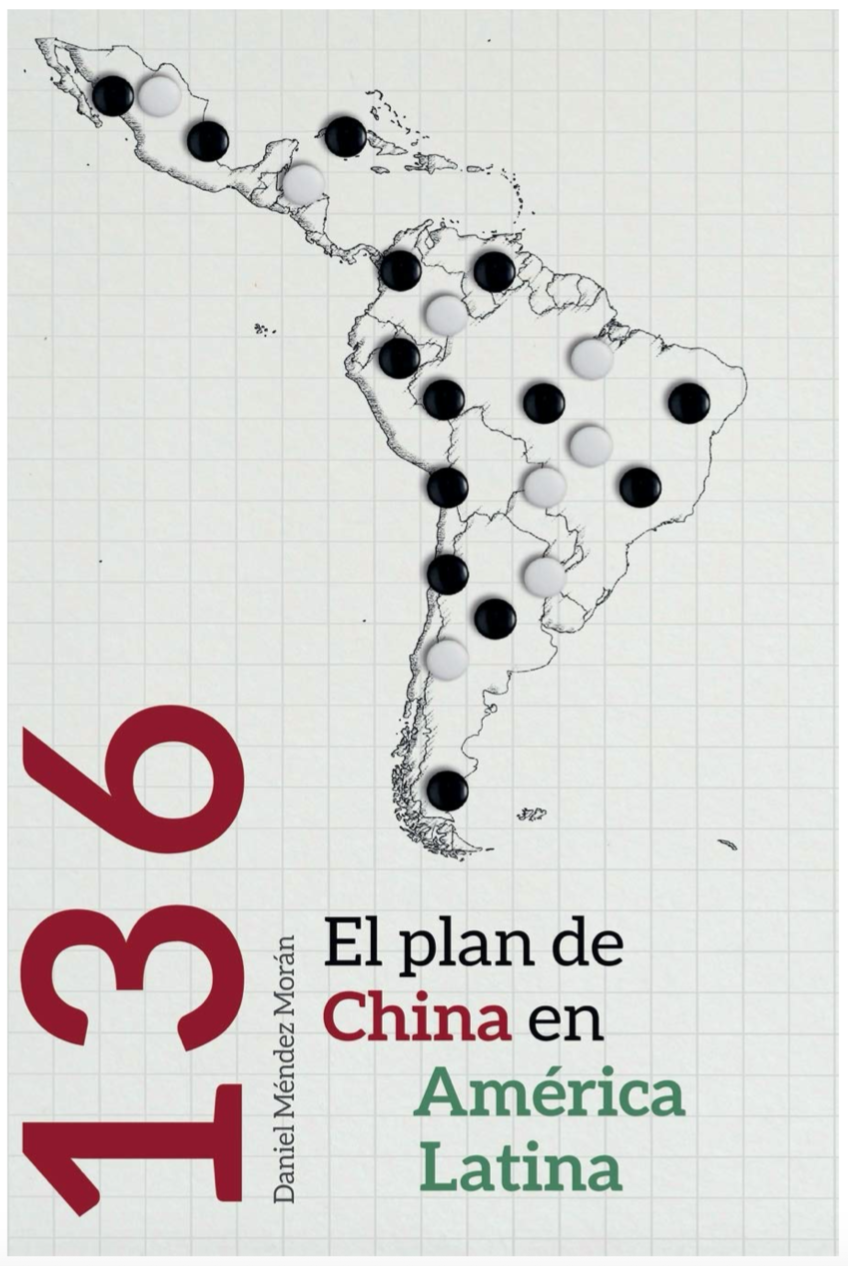
The book begins by briefly reflecting on China's rapid growth since the death of Mao Zedong and thanks to Deng Xiaoping's growth and opening-up policies between 1980 and 2000. This resurgence has not only been reflected in China's Economics but also in society. The new generations of Chinese professionals are better educated training and more fluent in foreign languages than their elders, and therefore better prepared for International Office. However, Liu Rutao, Economic and Commercial Counsellor at the Chinese Embassy in Chile explains to the author that "the history of China's going abroad is only fifteen years old, so neither the government nor the companies have a very mature thinking on how to act abroad, so we all need to study".
However, the country's short experience in the international arena is not an obstacle since, as the book shows, China has a very effective shortcut to accelerate this learning process: money. In fact, the goal of many of the most important Chinese investments in Latin America is not only access to natural resources, but also to human capital and, above all, to knowledge. Thanks to their huge financial resources, Chinese companies are acquiring companies with experience and contacts in the Americas, hiring the best professionals in each country and buying brands and technologies. "This phase is very difficult. Chinese companies are going to pay to learn. But everything is learned by paying," diplomat Chen Duqing, China's ambassador to Brazil between 2006 and 2009, explained to Méndez.
After this overview, the book moves on to China's relationship with different Latin American partners. In the case of Mexico, there is a struggle against the famous made in China. The empire at the centre went to Mexico 40 years ago to study the maquiladora programme; when they returned, Méndez explains, they said: "Mexico is doing that for the United States, we are going to do it for the world". And so, a few years later, China designed and improved the strategy. There is little doubt that made in China has won the day over Mexican maquiladoras, and it is all these decades of skill and frustration that explain the complex political relations between the two countries. This is what the people interviewed by the author testify to. To Jorge Guajardo, this model reminds him of the colonial order imposed by Spain and continued by the United Kingdom: "I sometimes said to the Chinese: 'Gentlemen, you cannot see America: Gentlemen, you cannot see Latin America as anything other than a place where you go for natural resources and in return you send manufactured goods. We were already a colony. And we didn't like it, it didn't work. And we chose to stop being one. You don't want to repeat that model".
The result of these new tensions is that neither country has achieved what it was looking for. Mexico has barely increased its exports to China and the Asian giant has barely increased its investments in the Latin American country. In 2017 there were only 30 Chinese companies installed in Mexico, a very small number compared to the 200 in Peru. Other diplomats on the continent recognise that in any international meeting where both countries are present, the Latin American country is always the most reluctant to accept Beijing's proposals. For China, Mexican 'resistance' is perhaps its biggest diplomatic stumbling block in the region: the best example that its rise has not benefited all countries in the South.
Méndez says that, unlike Mexico, Peru's mining strategy has found an ideal partner on the other side of the Pacific. In need of minerals to feed its industry and build new cities, China's huge demand has pulled strongly on the Peruvian Economics . Between 2004 and 2017, trade between the two countries increased tenfold and the Asian giant became Peru's first commercial partner . China is no longer only important for its demand for copper, lead and zinc, but also for its investment flows and its capacity to implement mining projects. These financial conditions, which are very difficult to obtain from private banks, are often the comparative advantage that allows Chinese state-owned companies to beat their Western competitors.
What does this mean for Latin America, and should Latin American countries be concerned about this political and economic strategy that invests massively in their natural resources through state-owned companies? As the book points out, many diplomats think it is necessary to be vigilant. Unlike private companies, whose primary goal aim is to make profits and submit dividends to their shareholders, Chinese companies are ultimately written request controlled by politicians who may have another diary. In this sense, the expansion of so many state-owned companies in natural resources can also become a weapon of pressure and influence.
If a Latin American leader, for example, decides to meet with the Dalai Lama or opposes a diplomatic initiative led by Beijing, the Asian giant could use its state-owned companies in retaliation, warns Méndez. In the same way that if the Peruvian government wanted to cancel some project chimo for labour or environmental infractions, Beijing could threaten to deny approval of phytosanitary protocols or delay other investments. Moreover, China is increasingly aware that its image, its capacity for persuasion and its cultural attractiveness (soft power) are vital to expand its political and economic project .
On the other hand, further south in the region, Uruguay has become the perfect laboratory for China. Uruguayan factories are prepared for short production runs of a few thousand cars, the country has a specialised workforce and the good infrastructure means that in a very short time it is possible to set up plants in Brazil or Argentina. It should be borne in mind that Chinese companies are still little known in Latin America and do not have many financial resources, and in Uruguay they can test the market.
As for Brazil, Méndez speaks especially of the diplomacy of satellites. Satellites are not only useful for bringing television to homes and for using GPS on mobile phones, but also for their military capabilities and the political prestige they imply. Brazil has collaborated with other countries such as Argentina and the United States, but political and economic tensions almost always limit space cooperation. Paradoxically, in the case of China, distance seems to be a blessing as there are no geopolitical problems between the two: sometimes it is more difficult to work with your neighbours than with people who are far away. For Beijing, space missions serve to enhance all dimensions of its power: it increases its military capabilities and contributes to its space industry and competitiveness in an economic sector with a bright future. And finally, it also serves as a public relations campaign in the world. However, the technological and economic differences are becoming so apparent that even China is outgrowing the South American giant.
From a geostrategic point of view, Méndez does not want to miss the construction of a Chinese space station on a 200-hectare plot of land in the Argentinean province of Neuquén, which has an initial investment of 50 million dollars and is part of China's moon exploration programme. Moreover, Argentina is the only country in which the presence of the Industrial and Commercial Bank of China is so popular in society. B . This Chinese bank has managed to offer the same services as any other banking institution in Argentina.
Finally, Chile is one of the countries with which Beijing has the best relations, but why does China not invest in Chile? The answer is simple. Investment processes in Chile are clear, transparent and equal for all countries. There are no exceptions and investors have to follow complex legal regulations to the letter. The business culture is different, and the Chinese don't like the idea of needing lawyers and 20,000 permits for everything. They like to pay bribes, and in Chile corruption provokes a lot of indignation.
Throughout this country-by-country analysis, the author has made one thing clear: China has a plan. Or at least, it has been able to bet for decades on the training of officials with the goal of designing a strategy in Latin America. This capacity for planning and these long-term objectives deadline have helped the Asian giant to advance its position in recent years and leave a deep mark on many countries in the American continent. And what does the plan consist of? It is clear that China's goal issue one is economic. It has managed to successfully "sneak" into the three major trade blocs that include Latin American countries: NAFTA, the Pacific Alliance and Mercosur.
But Economics per se is not the only thing that drives China. To achieve its economic goals, Beijing also needs to build political relations and allies that can defend its diplomatic positions. Its defence of non-interference in internal affairs and a multipolar world demands in return the silence of Latin American countries on human rights violations in their country and respect, for example, for the one-China policy. The Asian giant wants to expand all its strengths and is not willing to give up any of them.
In conclusion, whether or not China has a strategy for Latin America, Latin America does not have a strategy for China. And China is not an NGO; if recent history shows anything, it is that each country seeks to defend its own selfish national interests at the International Office level. China has its diary and is pursuing it. Perhaps the time has come for Latin America to have its own.
US LNG sales to its neighbours and exports from Latin American and Caribbean countries to Europe and Asia open up new prospects
Not relying on pipelines, but being able to buy or sell natural gas also to distant or land-locked countries improves the energy prospects of many nations. The success of fracking has generated a surplus of gas that the US has begun to sell in many parts of the world, including to its hemispheric neighbours, who in turn have more choice provider. At the same time, being able to submit gas in tankers has expanded the customer portfolio of Peru and above all Trinidad and Tobago, which until last year were the only two American countries, apart from the US, with liquefaction plants. Argentina joined them in 2019, and Mexico in 2020 has promoted investments to join this revolution.
![A liquefied natural gas (LNG) freighter [Pline]. A liquefied natural gas (LNG) freighter [Pline].](/documents/16800098/0/gas-natural-blog.jpg/bc7b4699-c26c-a2d1-2971-f57cbb0345b8?t=1621873574093&imagePreview=1)
▲ A liquefied natural gas (LNG) freighter [Pline].
article / Ann Callahan
The United States is connected by pipeline only to Canada and Mexico, but is selling gas by ship to some thirty other countries (Spain, for example, has become a major buyer). In 2019, the US exported 47.5 billion cubic metres of liquefied natural gas (LNG), of which one-fifth went to American neighbours, according to agreement with report BP 2020 on the sector.
Eight countries in Latin America and the Caribbean already have regasification plants for gas arriving by cargo ship in liquid form: there are three plants in Mexico and Brazil; two in Argentina, Chile, Jamaica and Puerto Rico, and one each in Colombia, the Dominican Republic and Panama, according to the annual summary association of LNG importing countries. In addition to the US, LNG also arrives in these countries from Norway, Russia, Angola, Nigeria and Indonesia. Two countries export LNG to various parts of the world: Trinidad and Tobago, which has three liquefaction plants, and Peru, which has one (another became operational in Argentina last year).
In an attempt to mitigate the risk of electricity shortages due to a decrease in hydropower production due to drought or other difficulties in accessing energy sources, many countries in Latin America and the Caribbean are turning to LNG. As a cleaner energy source, it is also an attractive option for countries already struggling with climate change. In addition, gas financial aid will help overcome the discontinuity of alternative sources, such as wind and solar power.
In the case of small island countries, such as those in the Caribbean, which for the most part lack energy sources, cooperation programmes for the development of LNG terminals can provide them with a certain independence from certain oil supplies, such as the influence exerted on them by Chavista Venezuela through Petrocaribe.
LNG is natural gas that has been liquefied (cooled to about -162°C) for storage and transport. The volume of natural gas in its liquid state is reduced by approximately 600 times compared to its gaseous state. The process makes it possible and efficient to transport it to places that cannot be reached by pipelines. It is also much more environmentally friendly, as the carbon intensity of natural gas is about 30% less than that of diesel or other heavy fuels.
The global natural gas market has evolved rapidly in recent years. Global LNG capacities are expected to continue to grow until 2035, led by Qatar, Australia and the US. According to BP's report on the sector, in 2019 the share of gas in primary energy reached an all-time high of 24.2%. Much of the growth in gas production in 2019, when it increased by 3.4%, was due to additional LNG exports. LNG exports last year grew by 12.7% to 485.1 billion cubic metres.
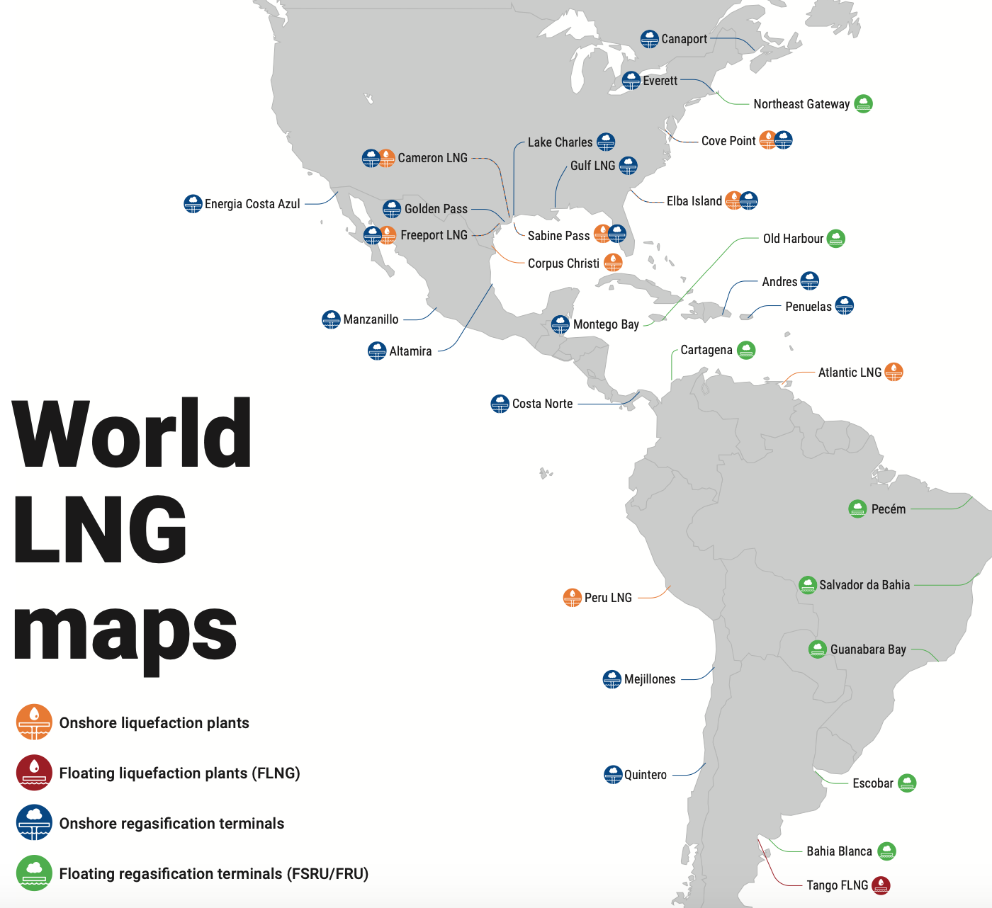
Liquefaction and regasification plants in the Americas [report GIIGNL].
Boom
While the United States lagged behind in gas production at the beginning of the first decade of this century, the shale boom since 2009 has led the US to exponentially increase gas extraction and play a key role in the global trade of the liquefied product. With the relatively easy transportation of LNG, the US has been able to export and ship it to many parts of the world, with Latin America, due to its proximity, being one of the regions that is feeling the shift the most. Of the 47.5 billion cubic metres of LNG exported by the US in 2019, 9.7 billion went to Latin America; the main destinations were Mexico (3.9 billion), Chile (2.3 billion), Brazil (1.5 billion) and Argentina (1 billion).
While the region has promising export potential, given its proven natural gas reserves, demand exceeds production and it must import. Venezuela is the country with the largest reserves in Latin America (although its gas power is smaller than its oil power), but its hydrocarbon sector is in decline and the largest production in 2019 came from Argentina, an emerging shale country, followed by Trinidad and Tobago. Brazil matched Venezuela's output, followed by Bolivia, Peru and Colombia. In total, the region produced 207.6 billion cubic metres, while its consumption was 256.1 billion.
Some countries receive gas by pipeline, as is the case of Mexico and Argentina and Brazil: the former receives gas from the US and the latter from Bolivia. But the growing option is to install regasification plants to receive liquefied gas; such projects require some investment, usually foreign. The largest exporter of LNG to the region in 2019 was the US, followed by Trinidad and Tobago, which, due to its low domestic consumption, exports practically all its production: of its 17 billion cubic metres of LNG, 6.1 billion went to Latin American countries. The third largest exporter is Peru, which sent its 5.2 billion cubic metres to Asia and Europe (it did not sell on the continent itself). Argentina joined exports in 2019 for the first time, although with a leave amount, 120 million cubic metres, almost all destined for Brazil.
The region imported a total of 19.7 billion cubic metres of LNG in 2019. The main buyers were Mexico (6.6 billion cubic metres), Chile (3.3 billion), Brazil (3.2 billion) and Argentina (1.7 billion).
Some of those that imported smaller quantities then re-exported part of the supplies, as did the Dominican Republic, Jamaica and Puerto Rico, generally with Panama as the main destination.
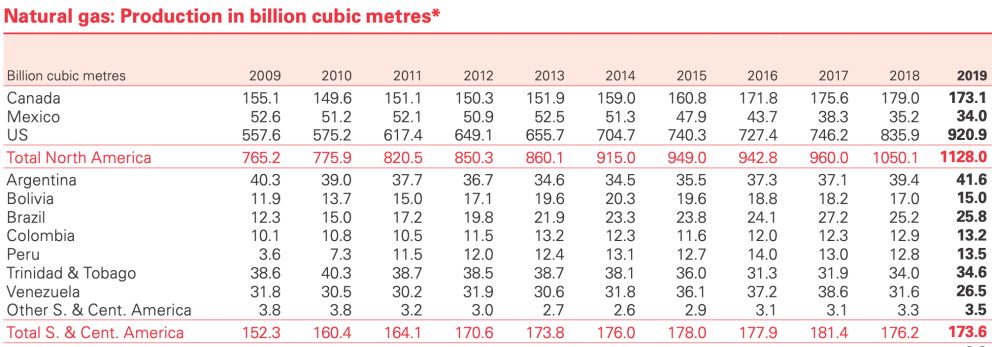


Tables extracted from report Statistical Review of World Energy 2020 [BP].
By country
Mexico is the largest importer of LNG in Latin America; its supplies come mainly from the US. For a long time, Mexico has relied on gas shipments from its northern neighbour via pipelines. However, the LNG development has opened up new prospects, as the country's location can help it boost both capacities: improved pipeline connections with the US may allow Mexico to have a gas surplus at Pacific terminals for re-exporting LNG to Asia, complementing the absence of liquefaction plants on the US West Coast for the time being.
The possibility of re-exporting from Mexico's Pacific coast to the large and growing Asian LNG market - without the need for tankers to pass through the Panama Canal - is a major attraction. agreement The US Energy department granted in early 2019 two authorisations to Mexico's project Energía Costa Azul to re-export US-derived natural gas in the form of LNG to those countries that do not have a free trade agreement (FTA) with Washington, as stated in the 2020 report of the group International Importers of Liquefied Natural Gas(GIIGNL).
For the past decade, Argentina has been importing LNG from the US; however, in recent years it has reduced its purchases by more than 20 per cent as domestic gas production has increased thanks to the exploitation of Vaca Muerta. These fields have also allowed it to reduce gas purchases from neighbouring Bolivia and sell more gas, also via pipeline, to its neighbours Chile and Brazil. In addition, in 2019 it will begin exporting LNG from the Bahía Blanca plant.
With Argentina pumping gas to neighbouring Chile, in 2019 Chilean LNG imports declined to their lowest Degree in three years, although it remains one of the important buyers in Latin America, having switched Trinidad and Tobago to the US as its preferred provider . It should be noted, however, that Argentina's export capacity depends on the levels of domestic flows, especially during winter seasons when widespread heating is a necessity for Argentines.
Over the past decade, Brazil' s LNG imports have varied significantly from year to year. However, it is projected to be more consistent in its reliance on LNG until at least the next decade, as renewable energy is developed. In Brazil, natural gas is largely used to back up Brazilian hydropower.
In addition to Brazil, Colombia also considers LNG as an advantageous resource to back up its hydroelectric system in low periods. On its Pacific coast, Colombia is currently planning a second regasification terminal. Ecopetrol, the state hydrocarbon business , will allocate USD 500 million to unconventional gas projects in addition to oil. Along with the government's authorisation to allow fracking, currently stagnant reserves are projected to increase.
Bolivia also has significant natural gas production potential and is the country in the region whose Economics is most dependent on this sector. It has the advantage of existing infrastructure and the size of neighbouring gas markets; however, it faces skill production from Argentina and Brazil. Also, being a landlocked country, it is limited in the commercialisation of LNG.
Although Peru is the seventh largest producer of natural gas in the region, it has become the second largest exporter of LNG. Lower domestic consumption, compared to other neighbouring markets, has led it to develop LNG exports, reinforcing its profile as a nation focused on Asia.
For its part, Trinidad and Tobago has adapted its gas production to its status as an island country, basing its hydrocarbon exports on tankers, which gives it access to distant markets. It is the leading exporter in the region and the only one with customers in all continents.
India's trade with the region has increased twenty-fold since 2000, but is only 15% of the trade flow with China.
China's rapid trade, credit and investment spillover into Latin America in the first decade of this century suggested that India, if it intended to follow in the footsteps of its continental rival, could perhaps stage a similar landing in the second decade. This has not happened. India has certainly increased its economic relationship with the region, but it is a far cry from that developed by China. Even Latin American countries' trade flows are greater with Japan and South Korea, although it is foreseeable that in a few years they will be surpassed by those with India given its potential. In an international context of confrontation between the US and China, India emerges as a non-confrontational option, specialising in IT services that are so necessary in a world that has discovered the difficulty of mobility for Covid-19.
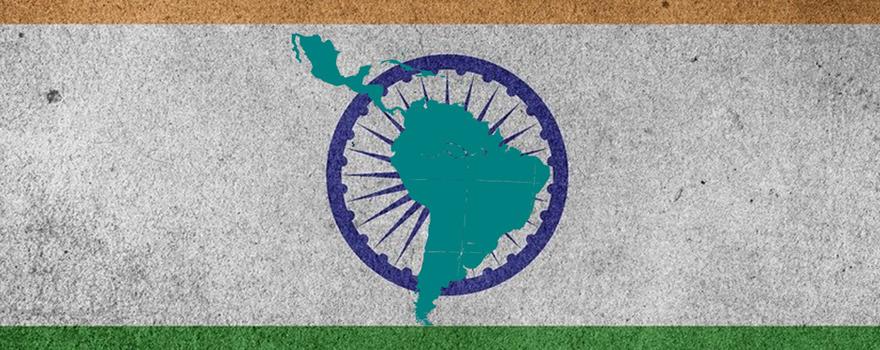
article / Gabriela Pajuelo
India has historically paid little attention to Latin America and the Caribbean; the same had been true of China, apart from episodes of migration from both countries. development But China's emergence as a major power and its landing in the region prompted the Inter-American Development Bank (IDB) to ask in a 2009 report whether, after the Chinese push, India was going to be "the next big thing" for Latin America. Even if India's figures were to lag behind China's, could India become an actor core topic in the region?
Latin American countries' relationship with New Delhi has certainly grown. Even Brazil has developed a special link with India thanks to the BRICS club, as evidenced by Brazilian president Jair Bolsonaro's visit in January 2020 to his counterpart Narendra Modi. In the last two decades, India's trade with the region has increased twenty-fold, from $2 billion in 2000 to almost $40 billion in 2018, as a new IDB report found last year.
This volume, however, falls far short of the trade flow with China, of which it constitutes only 15 per cent, because if Indian interests in Latin America have increased, Chinese interests have continued to do so to a greater extent. Investment from both countries in the region is even more disproportionate: between 2008 and 2018, India's investment was $704 million, compared to China's $160 billion.
Even India's trade growth is less regionally intertwined than global figures might suggest. Of the total $38.7 billion of transactions in 2018, $22.7 billion were Latin American exports and $16 billion were imports of Indian products. Indian purchases have already surpassed imports from Latin America by Japan ($21 billion) and South Korea ($17 billion), but this is largely due to the purchase of oil from Venezuela. Adding the two directions of flow, the region's trade with Japan and Korea is still larger (around $50 billion in both cases), but the potential for growth in the trade relationship with India is clearly greater.
There is interest not only from American countries, but also from India. "Latin America has a young and skilled workforce, work , and is rich in natural and agricultural resource reserves," said David Rasquinha, director general manager of the Export-Import Bank of India.
Last decade
The two IDB reports cited above are a good reflection of the leap in relations between the two markets in the last decade. In the 2009 report, under degree scroll 'India: Opportunities and Challenges for Latin America', the Inter-American institution presented the opportunities offered by contacts with India. Although it was committed to increasing them, the IDB was uncertain about the evolution of a power that for a long time had opted for autarky, as Mexico and Brazil had done in the past; however, it seemed clear that the Indian government had finally taken a more conciliatory attitude towards the opening up of its Economics.
Ten years later, the report graduate "The Bridge between Latin America and India: Policies for Deepening Economic Cooperation" delved into the opportunities for cooperation between the two actors and noted the importance of strengthening ties to favour the growing internationalization of the Latin American region, through the diversification of trade partners and access to global production chains. In the context of the Asian Century, the flow of exchange trade and direct investment had increased exponentially from previous levels, result largely due to the demand for Latin American raw materials, something that is often criticised as not fostering the region's industry.
The new relationship with India presents an opportunity to correct some of the trends in interaction with China, which has focused on investment by state-owned companies and loans from Chinese state-owned banks. In the relationship with India, there is greater participation of Asian private initiative and a commitment to new economic sectors, as well as the hiring of indigenous staff , including at the management and management levels.
agreement According to General Manager of the IDB's Integration and Trade Sector, Fabrizio Opertti, "the development of an effective institutional framework and business networks" is crucial. The IDB suggests possible governmental measures such as increasing the coverage of trade and investment agreements, the development of proactive and targeted trade promotion activities, boosting investments in infrastructure, promoting reforms in the logistics sector, among others.
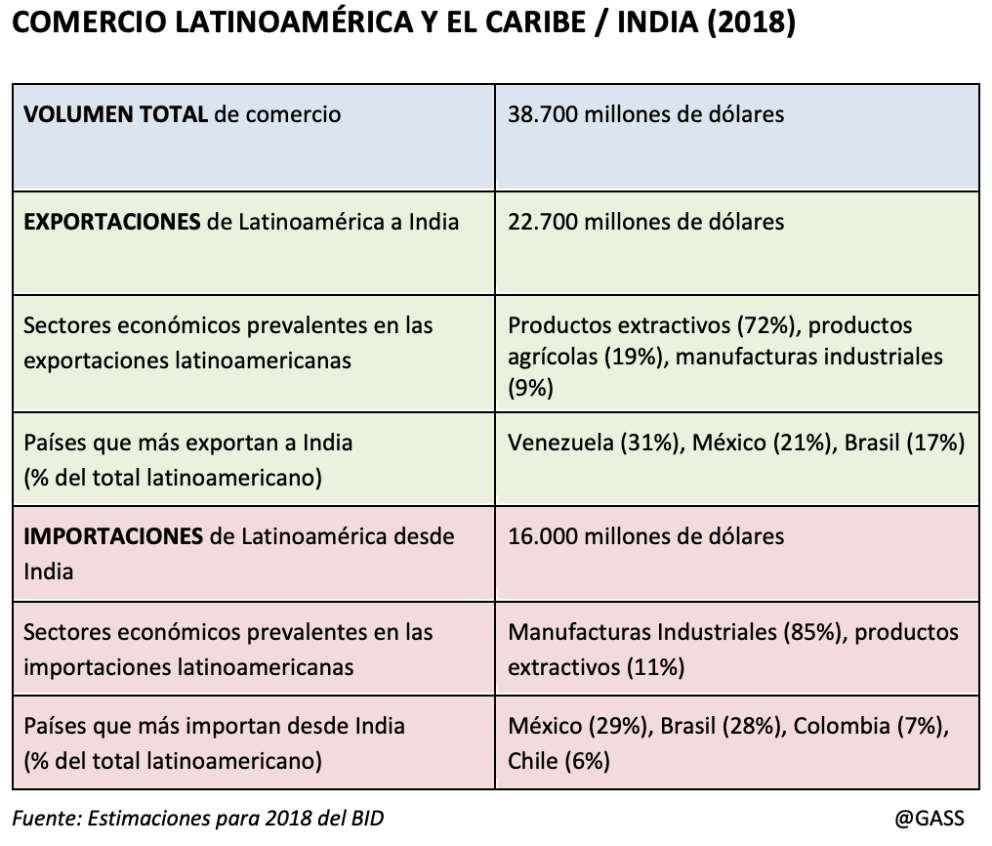
Post-Covid context
The questioning of global production chains and, ultimately written request, of globalisation itself because of the Covid-19 pandemic, is not conducive to international trade. Moreover, the economic crisis of 2020 may have a long-lasting effect on Latin America. But it is precisely in this global framework that the relationship with India could be particularly interesting for the region.
Within Asia, in a context of polarisation over the geopolitical interests of China and the United States, India emerges as a partner core topic , one might even say neutral; something that New Delhi could use strategically in its approach to different areas of the world and in particular to Latin America.
Although "India does not have pockets as deep as the Chinese", as Deepak Bhojwani, founder of the consultancy firm Latindia[1], says in relation to the enormous public funding that Beijing manages, India could be the origin of interesting technological projects, given the variety of IT and telecommunications companies and experts it has. Thus, Latin America could be the target of the "technology foreign policy" of a country that, according to agreement with its Ministry of Electronics and IT, has the ambition of growing its digital Economics to "one trillion dollars by 2025". New Delhi will focus its efforts on influencing this economic sector through NEST (New, Emerging and Strategic Technologies), promoting a unified Indian message on emerging technologies, such as governance of data and artificial intelligence, among others. The pandemic has highlighted Latin America's need for more and better connectivity.
There are two prospects for the expansion of India's influence on the continent. One is the obvious path of strengthening its existing alliance with Brazil, within the BRICS, whose pro tempore presidency India holds this year. That should lead to more diversified ties with Brazil, the region's largest market, especially in science and technology cooperation, in the fields of IT, pharmaceuticals and agribusiness. "Both governments committed to expand bilateral trade to 15 billion dollars by 2022. Despite the difficulties brought by the pandemic, we are pursuing this ambitious goal", says André Aranha Corrêa do Lago, Brazil's current ambassador to India.
On the other hand, a greater effort could be made in bilateral diplomacy, insisting on pre-existing ties with Mexico, Peru and Chile. The latter country and India are negotiating a preferential trade agreement and the Bilateral Investment Protection Treaty signature . A rapprochement with Central America, which still lacks Indian diplomatic missions, may also be of interest. These are necessary steps if, closely following in China's footsteps, India wants to be the "next big thing" for Latin America.
The increase in South Korean trade with Latin American countries has allowed the Republic of Korea to reach Japan's exchange figures with the region.
Throughout 2018, South Korea's trade with Latin America exceeded USD 50 billion, putting itself at the same level of trade maintained by Japan and even for a few months becoming the second Asian partner in the region after China, which had flows worth USD 300 billion (half of the US trade with its continental neighbours). South Korea and Japan are ahead of India's trade with Latin America (USD 40 billion).
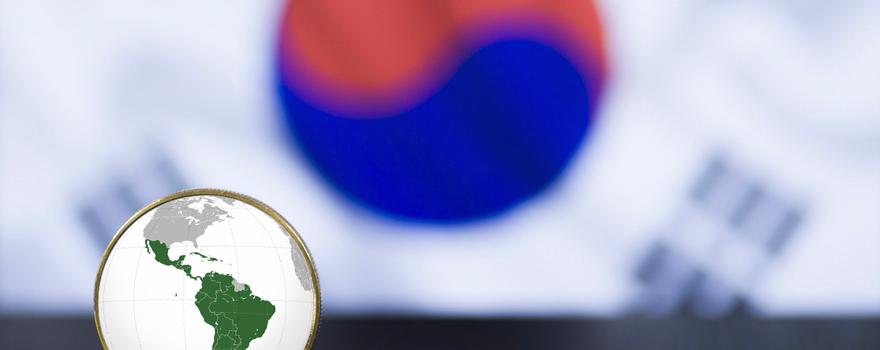
ARTICLE / Jimena Villacorta
Latin America is a region highly attractive to foreign markets because of its immense natural resources which include minerals, oil, natural gas, and renewable energy not to mention its agricultural and forest resources. It is well known that for a long time China has had its eye in the region, yet South Korea has also been for a while interested in establishing economic relations with Latin American countries despite the spread of new protectionism. Besides, Asia's fourth largest economy has been driving the expansion of its free trade network to alleviate its heavy dependence on China and the United States, which together account for approximately 40% of its exports.
The Republic of Korea has already strong ties with Mexico, but Hong Nam-ki, the South Korean Economy and Finance Minister, has announced that his country seeks to increase bilateral trade between the regions as it is highly beneficial for both. "I am confident that South Korea's economic cooperation with Latin America will continue to persist, though external conditions are getting worse due to the spread of new protectionism", he said. While Korea's main trade with the region consists of agricultural products and manufacturing goods, other services such as ecommerce, health care or artificial intelligence would be favourable for Latin American economies. South Korean investment has significantly grown during the past decades, from USD 620 million in 2003, to USD 8.14 billion in 2018. Also, their trade volume grew from USD 13.4 billion to 51.5 billion between the same years.
Apart from having strong ties with Mexico, South Korea signed a Free Trade Agreement with the Central American countries and negotiates another FTA with the Mercosur block. South Korea would like to join efforts with other Latin American countries in order to breathe life into the Trans-Pacific Partnership, bringing the US again into the negotiations after a change of administration in Washington.
Mexico
Mexico and South Korea's exports and imports have increased in recent years. Also, between 1999 and 2015, the Asian country's investments in Mexico reached USD 3 billion. The growth is the result of tied partnerships between both nations. Both have signed an Agreement for the Promotion and Reciprocal Protection of Investments, an Agreement to Avoid Income Tax Evasion and Double Taxation and other sectoral accords on economic cooperation. Both economies are competitive, yet complementary. They are both members of the G20, the OECD and other organisations. Moreover, both countries have high levels of industrialization and strong foreign trade, key of their economic activity. In terms of direct investment from South Korea in Mexico, between 1999 and June 2019, Mexico received USD 6.5 billion from Korea. There are more than 2,000 companies in Mexico with South Korean investment in their capital stock, among which Samsung, LG, KORES, KEPCO, KOGAS, Posco, Hyundai and KIA stand out. South Korea is the 12th source of investment for Mexico worldwide and the second in Asia, after Japan. Also, two Mexican multinationals operate in South Korea, group Promax and KidZania. Mexico's main exports to South Korea are petrol-based products, minerals, seafood and alcohol, while South Korea's main exports to Mexico are electronic equipment like cellphones and car parts.
Mercosur
Mercosur is South America's largest trading economic bloc, integrated by Argentina, Brazil, Paraguay and Uruguay. With a GDP exceeding USD 2 trillion, it is one of the major suppliers of raw materials and agricultural and livestock products. South Korea and Mercosur launched trade negotiations on May 2018, in Seoul. Actually, the Southern Common Market and the Republic of Korea have been willing to establish a free trade agreement (FTA) since 2005. These negotiations have taken a long time due to Mercosur's protectionism, so the Asian country has agreed on a phased manner agreement to reach a long-term economic cooperation with the bloc. The first round of negotiations finally took place in Montevideo, the Uruguayan capital, in September 2018. Early this year, they met again in Seoul to review the status of the negotiations for signing the Mercosur-Korea trade agreement. This agreement covers on the exchange of products and services and investments, providing South Korean firms faster access to the Latin American market. The Asian tiger main exports to South America are industrial goods like auto parts, mobile devices and chips, while its imports consist of mineral resources, agricultural products, and raw materials like iron ore.
Among Mercosur countries, South Korea has already strong ties with Brazil. Trade between both reached USD 1.70 billion in 2019. Also, South Korean direct investments totaled USD 3.69 billion that same year. With the conclusion of the trade agreement with the South American block, Korean products exported to Brazil would benefit from tariff eliminations, as would Korean position trucks, and other products going to Argentina. It would also be the first Asian country to have established a trade agreement with Mercosur.
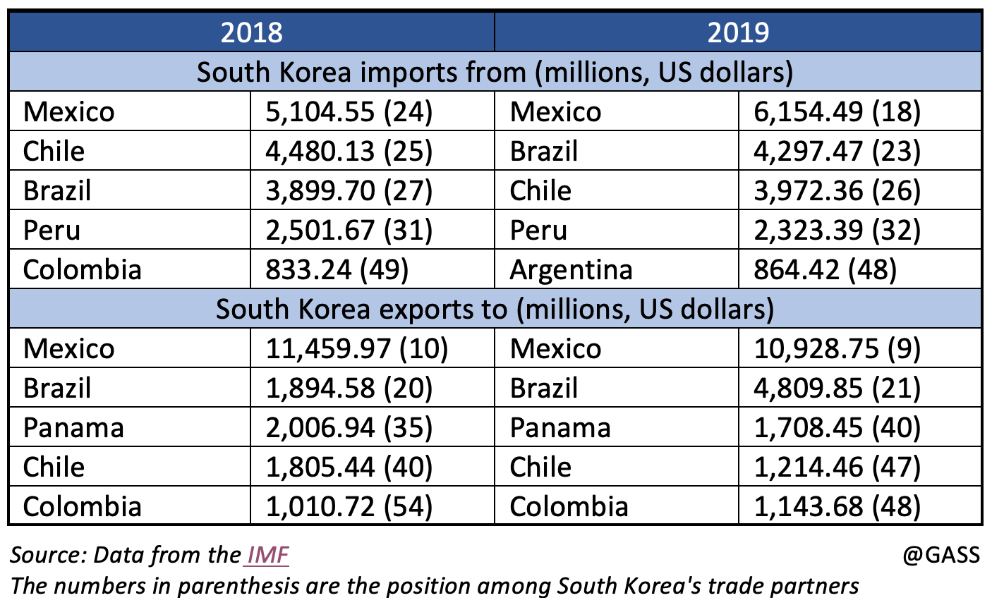
Central America
South Korea is the first Asian-Pacific country to have signed a FTA with Central American countries (Costa Rica, El Salvador, Guatemala, Honduras, Nicaragua and Panama). According to Kim Yong-beom, South Korean Deputy Minister of Economy and Finance, bilateral cooperation will benefit both regions as state regulatory powers won't create unnecessary barriers to commercial exchange between both. "The FTA will help South Korean companies have a competitive edge in the Central American region and we can establish a bridgehead to go over to the North and South American countries through their FTA networks", said Kim Hak-do, Deputy Trade Minister, when the agreement was reached in November 2016. Also, both economic structures will be complimented by each other by encouraging the exchange between firms from both regions. They signed the FTA on February 21st, 2018, after eighth rounds of negotiations from June 2015 to November 2016 that took place in Seoul, San Salvador, Tegucigalpa and Managua. Costa Rica also signed a memorandum of understanding with South Korea to boost trade cooperation and investment. This partnership will create new opportunities for both regions. South Korean consumers will have access to high-quality Central American products like grown coffee, agricultural products, fruits like bananas, and watermelons, at better prices and free of tariffs and duties. Additionally, Central American countries will have access to goods like vehicle parts, medicines and high-tech with the same advantages. Besides unnecessary barriers to trade, the FTA will promote fair marketing, ease the exchange of goods and services, to encourage the exchange businesses to invest in Central America and vice versa. Moreover, having recently joined the Central American Bank for Economic Integration (CABEI) as an extra-regional member, has reinforced the development of partner-economic projects around the region.
Opportunity
The Republic of Korea faces challenges related to the scarcity of natural resources, there are others, such as slower growth in recent decades, heavy dependence on exports, competitors like China, an aging population, large productivity disparities between the manufacturing and service sectors, and a widening income gap. Inasmuch, trade between Latin America and the Caribbean and the Republic of Korea, though still modest, has been growing stronger in recent years. Also, The Republic of Korea has become an important source of foreign direct investment for the region. The presence of Korean companies in a broad range of industries in the region offers innumerable opportunities to transfer knowledge and technology and to create links with local suppliers. FTAs definitely improve the conditions of access to the Korean market for the region's exports, especially in the most protected sectors, such as agriculture and agro-industry. The main challenge for the region in terms of its trade with North Korea remains export diversification. The region must simultaneously advance on several other fronts that are negatively affecting its global competitiveness. It is imperative to close the gaps in infrastructure, education and labor training.
One third of countries have developed a national cybersecurity strategy, but mobilized capabilities are minimal
A dozen Latin American countries have already developed a national cybersecurity strategy, but overall the capacities mobilized in the region to deal with cybercrime and cyberattacks are so far limited. In a continent with a high use of social networks, but at the same time with some problems of network electricity and internet access that make it difficult to react to cyber-attacks, the risk of widespread organized crime groups increasingly resorting to cybernetics is high.
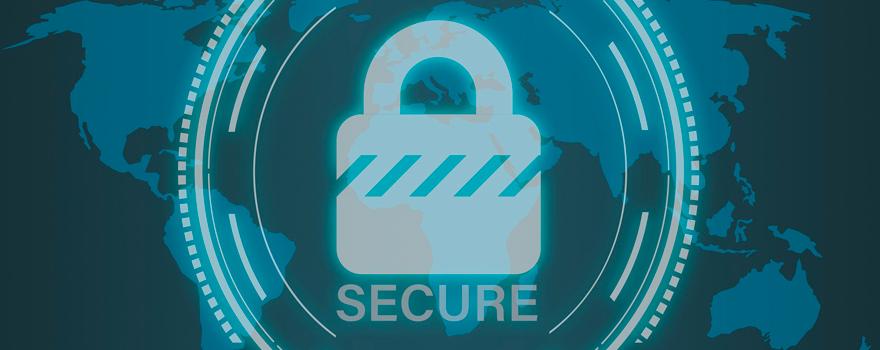
article / Paula Suárez
In recent years, globalization has made its way in all parts of the world, and with it have emerged several threats in the field of cyberspace, which requires special treatment by the governments of all states. Globally, and not only in Latin America, the main areas under threat in terms of cybersecurity are, essentially, computer crime, network intrusions and politically motivated operations.
The latest reports on cybersecurity in Latin America and the Caribbean, carried out jointly by the Inter-American Bank development (IDB) and the Organization of American States (OAS), indicate that one third of the countries in the region have begun to take some steps to address the growing cybersecurity risks. However, they also note that efforts are still limited, given the general lack of preparedness for the threat of cybercrime; they also point to the need for a reform of protection policies in the coming years, especially with the problems that have come to light with the Covid-19 crisis.
The IDB and the OAS (OAS) have collaborated on different occasions to publicize status and raise awareness of cybersecurity issues, which have been increasing as globalization has become part of everyday life and social networks and the internet become more deeply integrated into our day-to-day lives. To address this new reality, both institutions have created a Cybersecurity Observatory for the region, which has published several programs of study.
If until the 2016report cybersecurity was a topic little discussed in the region, currently with the increase of technology in Latin America and the Caribbean it has become a topic of interest for which states tend to be increasingly concerned, and therefore, to implement relevant measures, as highlighted in the 2020report .
Transportation, educational activities, financial transactions, many services such as food, water or energy supply and many other activities require cybersecurity policies to protect civil rights in the digital realm such as the right to privacy, often violated by the use of these systems as a weapon.
Not only socially, but also economically, investment in cybersecurity is essential to prevent the damage caused by online crime. For the Gross Domestic Product of many countries in the region, attacks on infrastructure can account for from 1% to 6% of GDP in the case of attacks on critical infrastructure, which translates into incompetence on the part of these countries to identify cyber dangers and to take the necessary measures to combat them.
According to the aforementioned study, 22 of the 32 countries analyzed are considered to have limited capabilities to investigate crimes, only 7 have a plan to protect their critical infrastructure, and 18 of them have established a so-called CERT or CSIRT (Computer Security Incident or Emergency Response Team). These systems are not currently developed uniformly in the region, and they lack the capacity and maturity to provide an adequate response to threats at network, but their implementation is necessary and, increasingly, they are supported by institutions such as the OAS for their improvement.
In this area, the Forum of Incident Response and Security Teams (FIRST) has a work core topic , because of the great need in this region, for attend to governments so that they can benefit from the identification of cyber threats and the strategic security mechanisms of the association, mainly to protect the economies of these countries.
As already mentioned, awareness of the need for such measures has been increasing as cyber attacks have also increased, and countries such as Colombia, Jamaica, Trinidad and Tobago and Panama have established a proper strategy to combat this damage. In contrast, many other countries in Latin America and the Caribbean such as Dominica, Peru, Paraguay and Suriname have lagged behind in this development, and although they are on the way, they need institutional support to continue in this process.
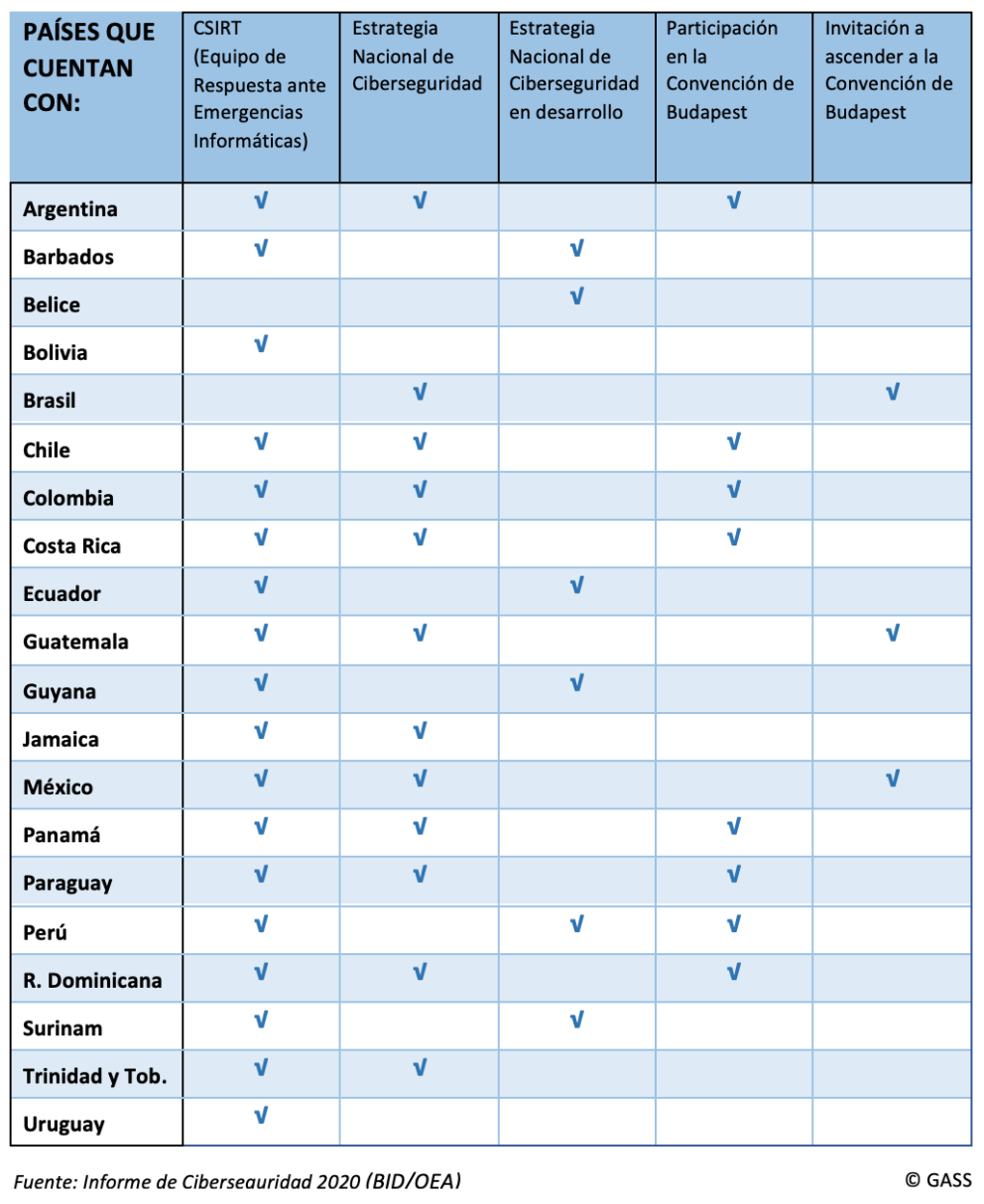
The problem in combating such problems is generally rooted in the states' own laws. Only 8 of the 32 countries in the region are part of the Budapestagreement , which advocates international cooperation against cybercrime, and one third of these countries do not have appropriate legislation in their legal framework for cybercrime.
For the states party to agreement, these guidelines can serve as a great financial aid to develop domestic and procedural laws with respect to cybercrime, so it is promoting the adherence or at least the observation of them from organizations such as the OAS, with the recommendations of specialized units such as group of work on Cybercrime of the REMJA, which advises on the reform of criminal law with respect to cybercrime and electronic evidence.
On the other hand, it was not until the beginning of this year that, with the incorporation of Brazil, 12 countries in Latin America and the Caribbean have established a national cybersecurity strategy, due to the lack of qualified human talent. Although it is worth mentioning the two countries in the region with the largest development in the field of cybersecurity, which are Jamaica and Trinidad and Tobago.
Of the problems mentioned, we can say that the lack of national strategy in terms of cybersecurity exposes these countries to various attacks, but to this must be added that the companies that sell cybersecurity services and provide technical and financial support in the region are mostly from Israel or the United States, and are linked to a rather militarized security and defense perspective, which will be a challenge in the coming years because of the skill that China is showing on this side of the hemisphere, especially linked to 5G technology.
Cyber malpractices are a threat not only to the Economics of Latin America and the Caribbean, but also to the functioning of democracy in these states, an attack on the rights and freedoms of citizens and the values of society. For this reason, the need for investment in civilian infrastructure and military capacity is becoming apparent. To achieve this, the states of the region are willing to cooperate, firstly, in the unification of their legal frameworks based on the models of the Budapest agreement and the instructions of the European Union, whose perspective to face the new challenges in cyberspace is having a great impact and influence in the region.
In addition, with the upcoming Covid-19 crisis, the states of the region are generally willing to collaborate by developing their own national strategies, consistent with the values of the organizations they are part of, to protect both their current means and their emerging technologies (artificial intelligence, quantum, computing from high performing and others). Cyber threats are intended to be addressed from channels open to partnership and dialogue, since the Internet has no borders, and the harmonization of legal frameworks is the first step to strengthen not only regional but also international cooperation.
